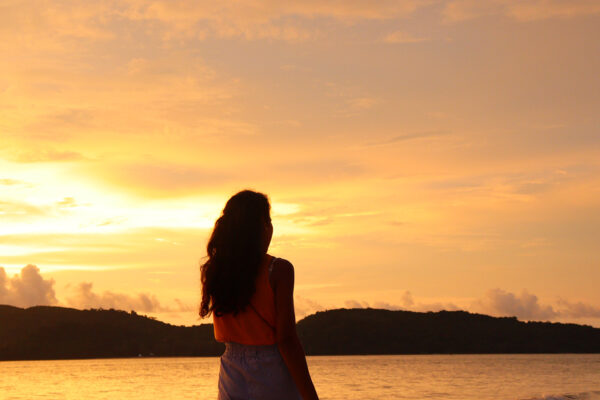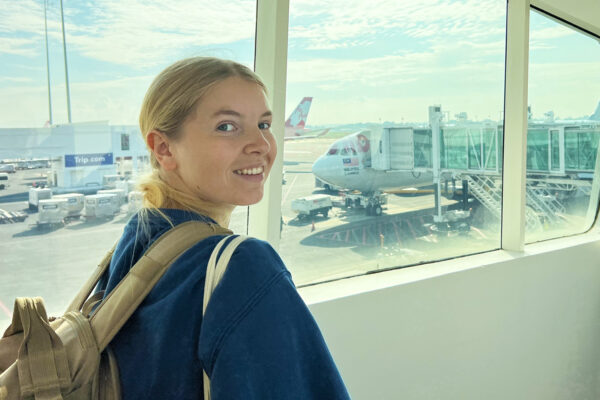
Malaysian Borneo sits at a conjunction of the equator, the thick emerald rainforest, and the turquoise-colored waters of the South China Sea. It is a true fever dream of a place, but in a good way — this is the land of misty jungle trails, orangutan-filled canopies, and firefly-lit river banks.
In this guide, I will go deep into the list of things to do in Borneo, catalogue the best beaches of the area, give you essential tips on where to stay, what to eat, and how to get from place to place on the island. Also I’ll sprinkle the must-do tours you should look into when planning your trip, and even give you a sneak peak into the neighboring country of Brunei!
Article contents
- Why come to Borneo?
- Requirements for visiting Borneo
- Best time to visit the island
- How to get to Borneo and how to get around
- Where to stay in Borneo?
- Local beaches
- Main sites and tours
- Cuisine and food prices
- A few notes about Brunei
- FAQ and our tips for visiting Borneo
Why come to Borneo?
Since the beginning of our extensive traveling journey, Malaysia has held a special place in my heart — the country has so much to offer to its visitors. From 📍 Kuala Lumpur’s dichotomy of tall skyscrapers and traditional shophouses, to 📍Malacca’s European-looking side streets and 📍Langkawi’s tropical paradise. Each of these destinations has already taken its place on this website and now it’s time for 📍Borneo.
Our last foray into the country started a little off Peninsular Malaysia — on Perhentian Islands, only to then do a complete 180, with us traveling all the way to Borneo, the third largest island in the world, after Greenland and New Guinea.
The island’s layout may be a tad confusing, so try and keep up: Borneo is divided between three countries — Malaysia, Indonesia, and Brunei. The island is often referred to as Kalimantan — this is the name most used by the Indonesians, since their chunk of the land is the biggest of all three.
We haven’t yet visited the Indonesian side of Borneo, though we made a quick detour to Brunei (read more on the experience further down). For now, I focus on the part of the island that is Malaysian.
The breakdown doesn’t stop there! The Malaysian part of Borneo is, in turn, comprised of two states — Sabah and Sarawak. Both states have ample opportunities for admiring the island’s wildlife; after all, Borneo is home to one of the oldest rainforests in the world!
- Each state adds its own unique flair to the equation — Sabah’s beaches and animal sanctuaries have a completely different vibe from Sarawak’s deep forests and large cave systems.
There is also a small island federal territory — Labuan, but it’s pretty tiny and doesn’t have the pull its larger neighbors have on visitors of Malaysia. You only need to remember the name if you’re landing in Brunei and then want to make your way into Borneo via a ferry ride (more on this later).
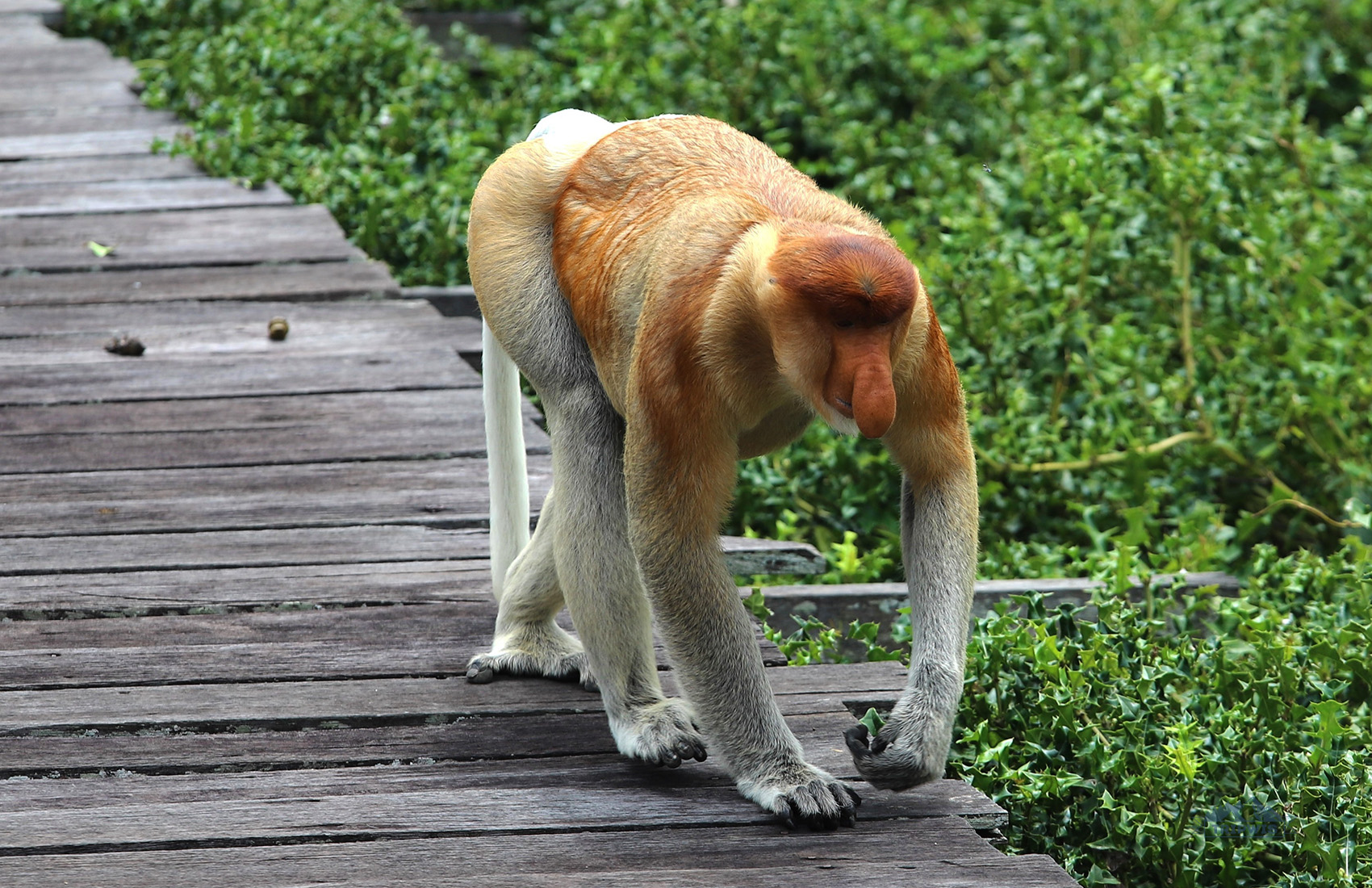
Why visit Borneo? The reasons are endless:
✔️Great snorkeling and diving opportunities — Sabah’s beaches are home to colorful reefs that are teeming with fish and turtles, among other marine animals
✔️Adrenaline-inducing rafting down the rivers — there are options for both complete beginners and seasoned adventurers
✔️Trekking and hiking routes through the rainforests, up the mountains, or on the many islands
✔️Important (but not stuffy) historical destinations — ancient cave systems with wall paintings from people that lived in the primeval forest thousands of years ago
✔️And last but not least — wildlife! Intelligent orangutans, annoying macaques, funny sun bears, weird-looking proboscis monkeys, (relatively) tiny pygmy elephants, and so many species of birds I’ve lost count — Borneo’s biodiversity outshines the rest of the world so much that it will be hard to get excited again about other natural destinations after visiting this one!
It also helps that Borneo is a pretty developed tourist destination. The prices for transport, food, and accommodation are also quite reasonable here, particularly during low season.
So what are you waiting for? Grab a pen and start planning your next Borneo adventure — it’s going to be a *wild* one!
Requirements for visiting Borneo
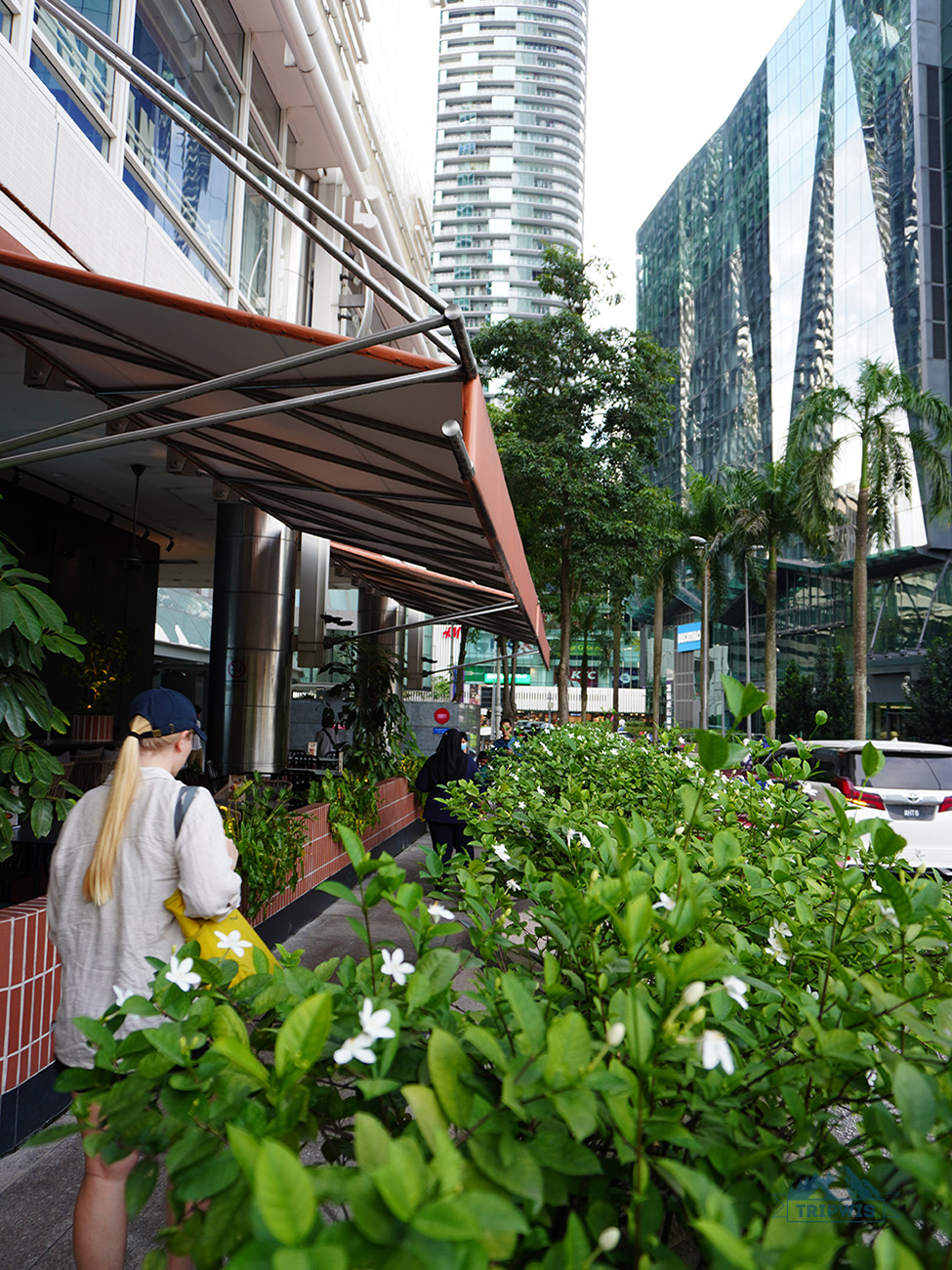 |
 |
There aren’t that many rules for entering the island’s Malaysian part, though you should keep a few things in mind when planning your trip.
The most pressing question is whether or not you need a visa for entering Borneo, Malaysia. If you’re a citizen of Australia, Canada, the US, the EU, or Japan, you have the option of a visa-free entry for up to 90 days. There are also instances of the visa-free period being way shorter (30 days max).
What you DO need for a fuss-free entry to Borneo:
- Passport that is valid for at least six months from the date of your entry
- Malaysia Digital Arrival Card (MDAC) — all foreign citizens must complete and submit MDAC online within 3 days before arrival in Malaysia. Though it is digital, you better have a printed out copy ready, just in case
- Proof of a return or onward ticket — whether the ticket itself or proof of funds to purchase one (they could potentially ask for proof of sufficient funds for the entire trip and/or tour and accommodation bookings, though these are not mandatory requirements)
- Travel insurance — though, again, not mandatory; it is better to have some coverage when traveling to Borneo (particularly if you’re planning on doing some extreme adventures, like rock-climbing)
If you plan on renting a car in Borneo, then don’t forget your national driver’s license (an International Driving Permit is not required, though it is recommended you have one anyway).
One particular quirk does find its way into the process of entering Borneo — even if you are traveling on a domestic flight from Peninsular Malaysia (from Kuala Lumpur, for example), you will still be expected to go through immigration again in Borneo’s Sabah or Sarawak. Their own border control is due to the states’ historical autonomy. You will receive proper entry and exit stamps in your passport.
Best time to visit Borneo
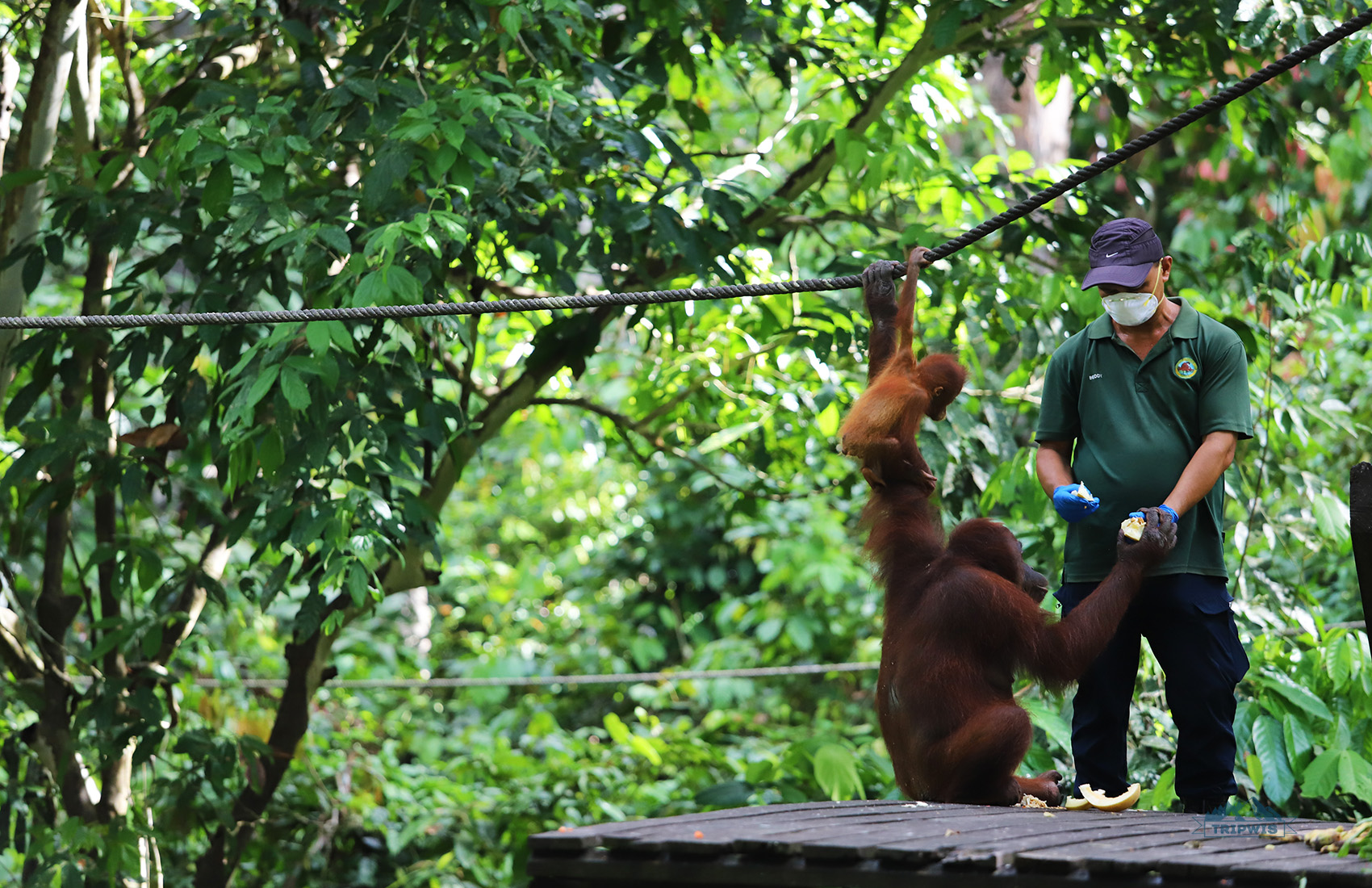
Borneo’s entire MO hinges upon it being a year-round destination — it’s a tropical climate, after all! Borneo weather and seasons have their particular traits, but two things stay the same, no matter the month: You can safely assume that the air temperatures will be high (+27°C…+32°C on average) and that the water temperatures will be comfortable for swimming.
The best time to visit Borneo is a period from June to September (the island’s dry season). Expect plenty of sun and an occasional shower — though rains tend to be pretty short-lived during this period. Humidity levels are also not that crazy during these months — if you have curly hair, you won’t go full Roseanne Roseannadanna! Last time we visited Borneo was in June, and we saw barely a drop of rain — a very lucky occurrence for our jam-packed outdoor itinerary.
Wet season in Borneo, according to different sources, peaks during the months of March and May, October and November, or December and February. Either way, it will still be hot (+28°C…+31°C) and humid — no difference there.
The monsoon season on the island brings both cons and, surprisingly, pros to the experience:
+ The rivers and waterfalls are at their fullest during this time; expect a younger cousin of Niagara Falls wherever you turn your gaze
+ The rainforest comes into its most beautiful form after heavy rainfall — you haven’t seen green before coming to Borneo’s jungle
+ Lack of crowds and lower prices — hotel rates plunge to more budget-friendly rates, and the wilderness once again looks wild, without tons of tourists crowding the most notable natural destinations.
— Mosquitos are back with a vengeance — mosquito-borne illnesses become more widespread (particularly in more forested areas). Use DEET repellent, wear long sleeves, and sleep under nets
— Leeches sightings also increase during wet season — leech socks are Borneo’s most happening fashion trend for the most part of the year!
— Heavy rain may lead to tour cancellations and more difficult transit between locations. The roads can get washed out, so some sites may become completely unreachable
— The sea’s choppy conditions during monsoon season may lead to ferry disruptions and some water activity cancellations
Mosquitos and leeches aren’t the only travelers’ nemeses in Borneo — at certain times (usually the phenomenon lasts for one to two weeks between the months of February and May), this lush paradise can also become home to toxic microscopic plankton. Yes, plankton — Mr Krabs’ business rival, but not a single organism — an entire population explodes in size, which leads to the local waters taking on a reddish brown color. Why do I have such beef with what is essentially a simple algae variety? Despite being visually striking, the “red tide” as it is called here is toxic — look out for beach signage, as it is prohibited to swim in the water during the algae bloom. Some beaches also issue alerts about jellyfish in the water, so keep an eye out!
How to get to Borneo?
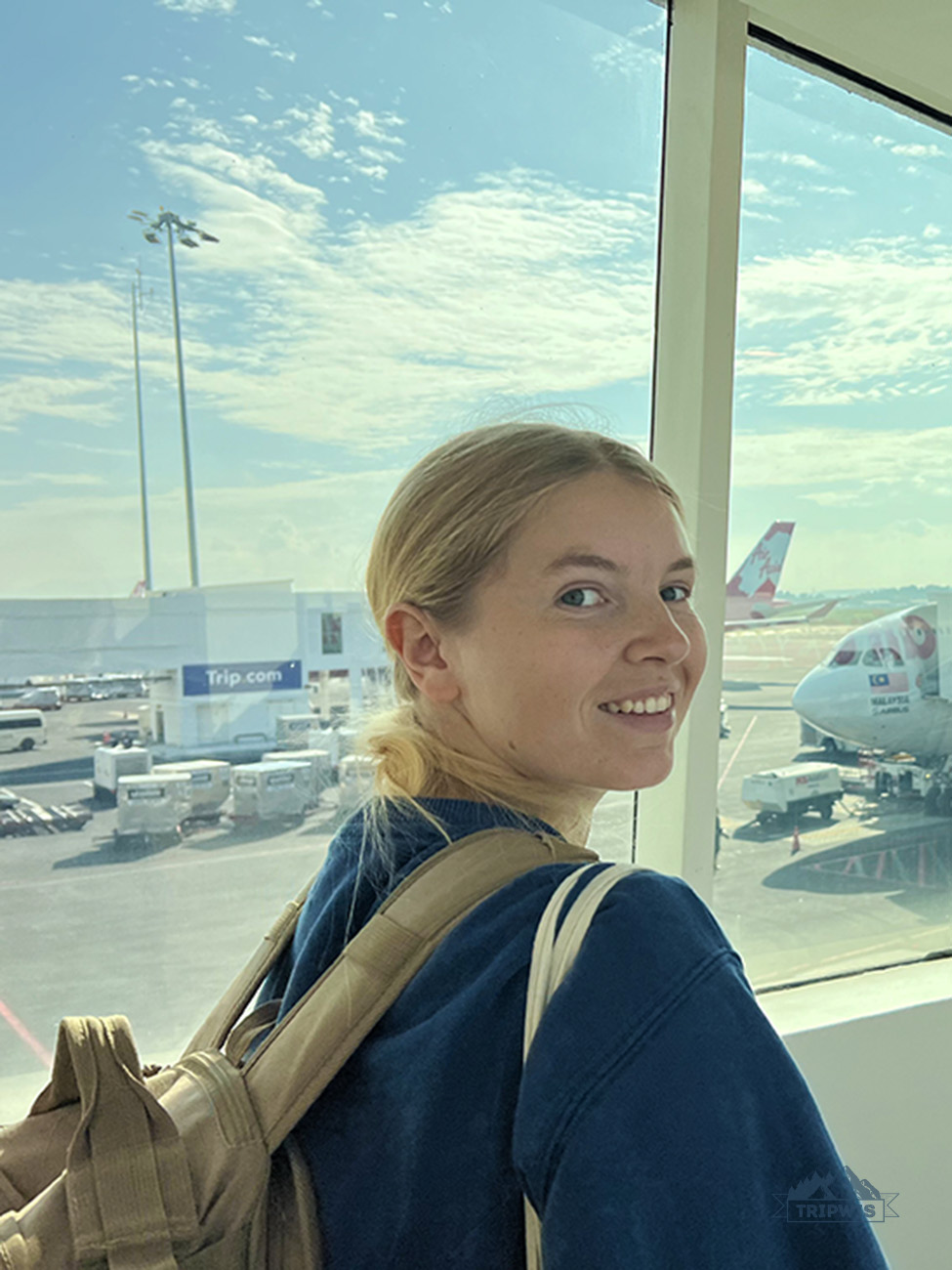 |
 |
There are two primary entry points to Borneo’s Malaysian side:
- Kota Kinabalu International Airport in Sabah
- and Kuching International Airport in Sarawak
A direct flight is an easy answer to the question of how to get to Borneo from Kuala Lumpur (obviously), Brunei*, Singapore, China, Vietnam, Taiwan, Indonesia, the Philippines, and a handful of other countries.
I like to scour the internet for the best deals on tickets when planning our trips, and Trip.com has always been a great help in these efforts, especially in Asia.
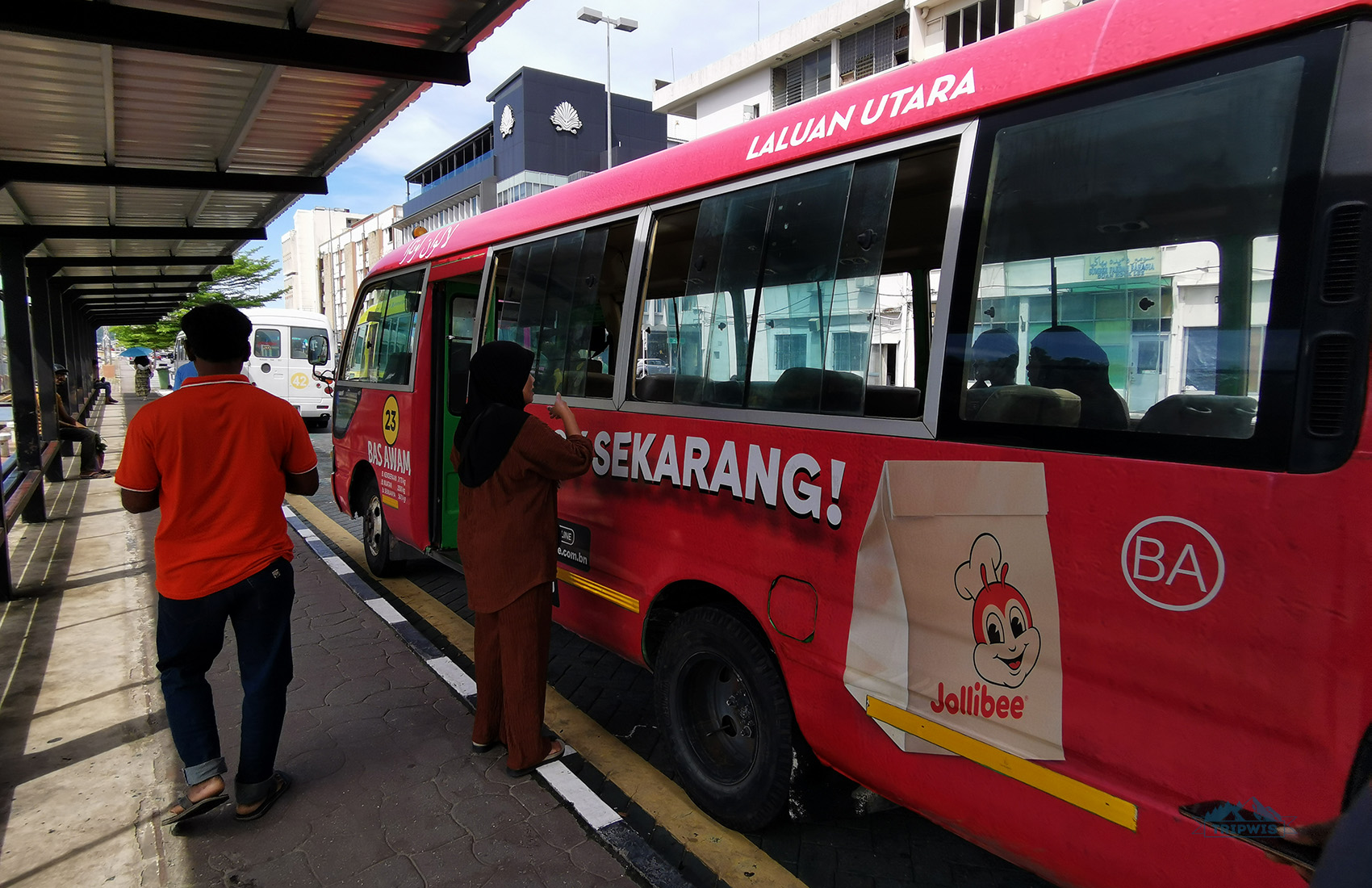
When looking at flights to Borneo, I found that routes from Europe have at least two stops (first differs, but Turkey and Qatar show up more than others; and the second one is usually a stop at Kuala Lumpur), while you could potentially find a flight with one stop (in China, Singapore, or Taiwan) when flying in from North America.
When it comes to prices, here’re approximate costs of flights to Borneo for July 2026 (high season):
- Flights from Germany or Paris start from $450 per person
- Flights from L.A. or New York start from $550 per person
When choosing a base for your Borneo adventures, it’s better to weigh out the number of sites you plan to visit in each state — Sabah and Sarawak. Their respective capitals (Kota Kinabalu and Kuching) are major hubs for exploring the rest of the island. I’ll give you quite a few recommendations of things to see and do in Borneo further down — use them to figure out where to land to hit the ground running quicker and more efficiently.

No matter which international airport (and the respective city) you choose, there are a few things to keep in mind here:
- Our chosen route — a flight from Kuala Lumpur to Kota Kinabalu (Sabah) lasts roughly 2 hours 30 minutes. It will take mere 15 minutes to drive from the airport to the city center — the distance between the two is about 8 km. You can either book a transfer on Klook (from $18) or a taxi via Grab app ($5).
- A flight from Kuala Lumpur to Kuching (Sarawak) lasts roughly 1 hour 50 minutes. It will take closer to 20 minutes to drive the 11 km from the airport to the city center. The taxi will cost around $10.
*If you found yourself exploring Brunei before deciding to move your efforts to Borneo, then a flight is not the only viable option of transferring between the two destinations. You can actually take a ferry from Brunei to Kota Kinabalu. It is not a direct route, however — you take the first ferry from Brunei (Muara or Serasa) to Labuan, Malaysia (remember, it’s a small island federal territory I’ve mentioned above?), go through immigration, and then take the second ferry from Labuan to Menumbok as the direct ferry to Kota Kinabalu doesn’t operate anymore. After that, it’s a 2.5 hour bus ride (20 MYR / $4.85) and you’re finally in Kota Kinabalu!
How to get around Borneo?

As I’ve already discussed, the entirety of Borneo island is impressive in size — it’s the third largest island in the world, for crying out loud! And even though the Indonesian region — Kalimantan — covers a huge chunk of the land, the Malaysian part is still pretty expansive. So much so, that domestic flights seem to be the more popular way of getting around Borneo states.
How to get around Borneo:
- Via a domestic flight — they are relatively inexpensive on the island and can be booked well in advance on Trip.com. The flight from Kota Kinabalu to Kuching costs $35 one way. Sometimes it’s the only way to get somewhere — for example, to Gunung Mulu National Park as there are literally no roads.
- By bus — Malaysian Borneo has a pretty well-developed public transport system. A short bus ride within city limits will not cost more than 5 MYR / $1.2. Major cities are connected with the help of several operators but there’s no need to list the names because if there’s an intercity bus route, then you’ll find it on 12GoAsia, together with its schedule.
Personal experience: We’ve traveled on a night bus from Kota Kinabalu to Sandakan (7 hours, 46 MYR / $11.1) and an aforementioned day bus from Menumbok to Kota Kinabalu (2.5 hours, 20 MYR / $4.85). Both were fine experiences not without the usual pitfalls, but hey, nobody’s perfect. Get your tickets in advance (and avoid seats near the restrooms) and pack a warm layer for the ride — local buses tend to blast AC like it’s the Sahara Desert out there.
- By taxi — use Grab or make sure the cab has a meter. Taxis are relatively inexpensive in Borneo (longer distance rides understandably cost more). The locals here are welcoming, so strike up a conversation with your taxi driver — they can give you precious info you would never find online. If you’re traveling on a strict budget, try and look for fellow travelers to divide a taxi fare with — a drive from the airport will be a steal if shared with two or three people.
Personal experience: We lucked out with a great driver during our last trip — our hostel booking fell through, and the driver offered to take us from Sandakan to Sepilok, wait for us there, also show us a few great local sites in the process, and then to return us back to the station (it totaled up to be an entire day) — all for 100 MYR ($24).
- By a rented car — some people are hard-set individualists that like to explore the unfamiliar territories on their own terms and at their own pace. If it sounds like you, consider using DiscoverCars for renting a car in Borneo (the prices start from $15 a day during low tourist season). While not necessary on the main roads, I would recommend renting a 4×4 if you plan on exploring more off-the-beaten-path locations, like national parks and some remote villages. Turn away from a major road and you’ve got yourself in less-than-ideal conditions. Rainy season also means deteriorating road state.
Where to stay in Borneo?
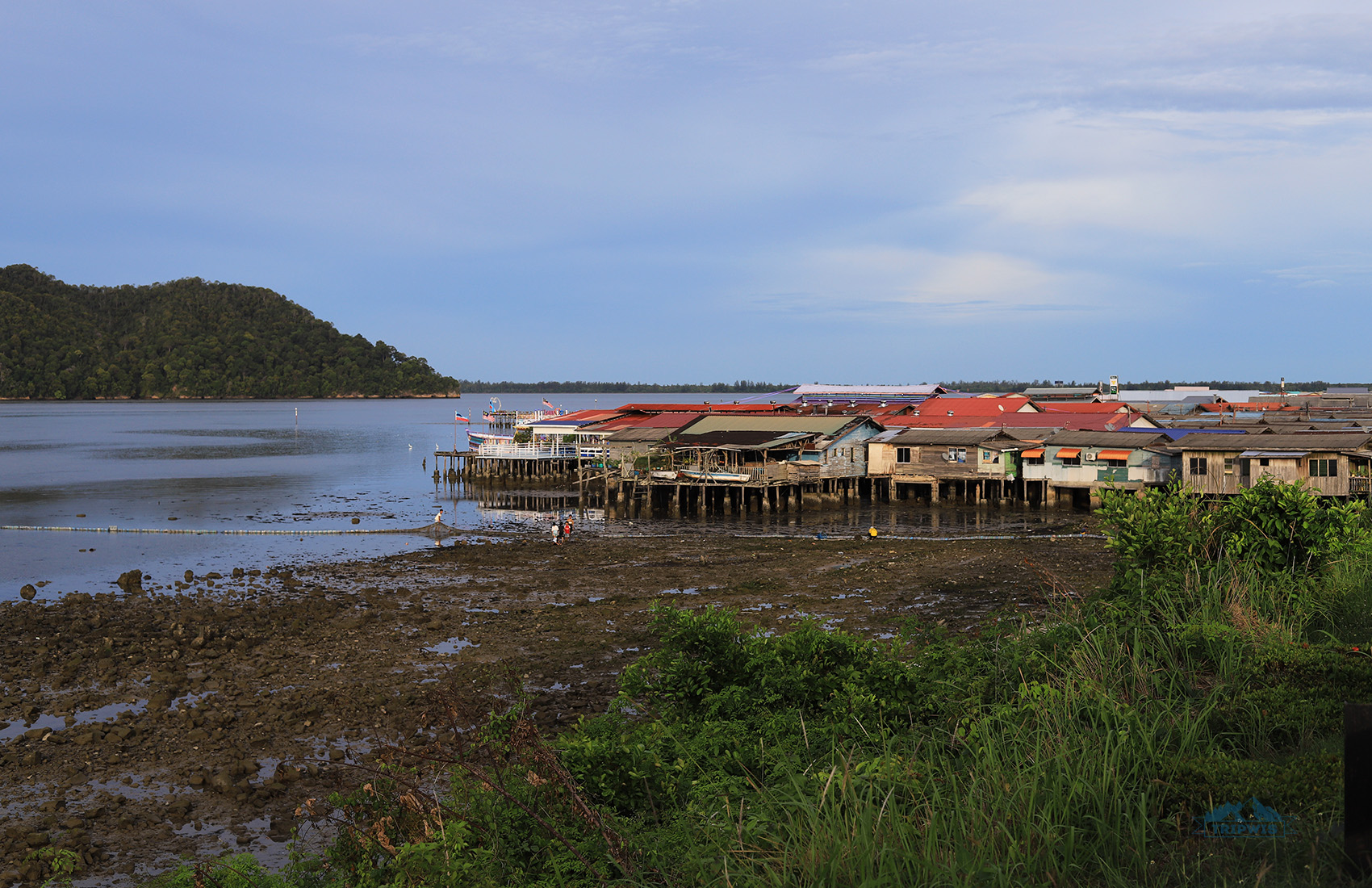
The cost of travel in Borneo varies depending on your style — of course, you can do hostels, cheap eateries, and public transport as the main mode of transportation, and you’ll save quite a bit of cash! However, the main island activities (think organized tours, parks’ entry fees and the like), more comfortable stays, and going to more remote locations (having to rely on taxis heavily in these cases) can rack up a substantial bill.
Thankfully, Borneo’s diversity doesn’t stop on its flora and fauna. The wild mix of stays for every budget — be it a beachfront resort or a small city crash pad with a bed and nothing else — invites plenty of wiggle room when planning your trip. Your Borneo sojourn price tag highly depends on your chosen base and the seasonality.
Sabah or Sarawak? Personally, we leaned more towards the first one. We based ourselves in Kota Kinabalu — it had a higher concentration of the sites we wanted to explore. Plus, it was a great getaway into another iconic location of Sabah state — the city of Sandakan, set on the northeast coast of Borneo which you can easily reach via a short domestic flight. Why go there? Sandakan’s pride and joy — Sepilok Orangutan Rehabilitation Centre — is reason enough to come all the way to Borneo, but more on it later!
Booking isn’t the main player in Asia. I found better deals on Trip.com — $20–$30 cheaper at times.
Here are some of the resorts and hotels I recommend on the island (in no particular order):
- 5* Shangri-La Tanjung Aru (Kota Kinabalu; from $190 a night) — set within mere 200 meters from the famed Tanjung Aru Beach (and a short drive from the airport), this hotel steps up to its luxury name. Beachfront location means stunning sea views that stretch over the horizon and a list of activities that will make you want to extend your stay: You can try your hand at surfing, diving, or even jet skiing. More of a homebody? Splash about at one of the hotel’s pools, fit in a quick workout at the fully stocked gym, or let your worries melt away at the iconic Chi Spa. A stay at the hotel is repeat-worthy if you’ve got the funds for it!
- 2* Casuarina Hotel (Kota Kinabalu; from $25 per night) — if you’re traveling on a strict budget, this hotel would be a great alternative to the aforementioned luxe digs — after all, the two are located in roughly the same area. At Casuarina, you can enjoy the spoils of easy beach access (and the short transfer to the airport), spick-and-span (but quite modest) rooms, and the dining options. That’s right — there is a coffee shop AND a restaurant that you can choose between for grabbing a bite. Tour and transfer arrangements that the hotel can do for you is a godsend for a first-time Borneo visitor.
- 5* Mulu Marriott Resort & Spa (Mulu; from $145 a night) — a great place to stay if you’re visiting Gunung Mulu National Park. They’ll pick you up from Mulu Airport for free and drop you off at the park whenever you need. And of course, it’s a Marriott, with all the standards that come with the name, and perfectly blended into the jungle. The hotel is built on stilts with wooden walkways, and every time you step out of your room — whether it’s for a generous breakfast, a cocktail at the bar, or a swim in the pool — it feels like you’re stepping straight into the heart of the tropical flora and fauna.
- 4* Sutera Sanctuary Lodges At Manukan Island (Kota Kinabalu; from $125 per night) — a perfect option of a stay in Borneo if you want to experience idyllic days while still being close to all the action. The lush lodges are located on a small Manukan Island (I mention it in Borneo Beaches section), just a 15-minute speedboat ride away from Kota Kinabalu’s Sutera Harbor. The island’s powder-soft beach is a main selling point of the resort; though the waterfront tends to be a tad crowded in the first half of the day, due to day-trip boat passengers. However, they all depart after 4 p.m., leaving the resort’s guests as sole adventurers. The rooms at Sutera are fit with cinematic sea views, and the facilities on offer alleviate any feeling of being a castaway. The island itself is clad with an easy trail, great for after-dinner golden hour walks.
- 4* Damai Beach Resort (Santubong; from $90 a night) — Sarawak’s darling hotel with unbeatable location. Hidden away between the sea and the rainforest-covered Mount Santubong, the resort’s setting looks like something out of a fairytale. It’s an hour’s drive to Kuching — the state’s capital; add another 10 to 15 minutes and you’re at the airport. The usual roster of facilities (gym, spa, pool, conference room) is embellished with a golf course — now it feels like true luxury indeed. Though seemingly perfect, a lot of guests note that some parts of the property feel dated, and would benefit from a small renovation.
- 2* Prima Hotel (Sandakan; from $35 a night) — one of the cheapest hotels in Sandakan which I justified for myself because of the many parks and sanctuaries we wanted to visit in the region! It turned out to be decent and clean. If you want something “closer to nature”, have a look at 2* Tanini Sepilok (from $90) — it’s located right next to three must-visit spots of Sandakan.
Borneo beaches

No Borneo itinerary is complete without mentioning the island’s dreamy beaches — apart from the rainforest and the wildlife, they are one of the reasons that travelers flock to the area from all over the world. Most beaches in Malaysian Borneo states are public — only a handful of 4* and 5* resorts claim their own private (or semi-private) waterfronts.
The beaches all across the Malaysian part of Borneo are wonderful, but the greatest concentration of them is near Kota Kinabalu. The white sand here tends to be velvety soft, and the beach stretches are usually backed by green backgrounds. You can swim here as many spots are sheltered by coral reefs, which alleviate the problem of waves and invite even more wildlife into the equation — colorful fishes and other marine inhabitants call the reefs their home.
On top of that, Kota Kinabalu’s Jesselton Point is a busy jetty where you can hop on a speedboat and be taken to one of the coral-rich isles of Tunku Abdul Rahman Marine Park (Mamutik, Manukan, Sapi, Sulug, or Gaya) — there are multiple operators present on the route, which makes the entire process a fast and simple one.
Side note: Come early to snag a seat on the boat that covers multiple beaches. We were a tad late (coming to the jetty at noon) and had only a couple options to choose from — a group tour to Mamutik or a group tour to Manukan. Mamutik promised great snorkeling and lots of wildlife sightings; plus, it was the closest one to mainland. The tour ended up costing 30 MYR ($7.25) and we had a pleasantly fun time on the island.
But let’s dive into more details about the beaches! Here are my personal recommendations; I’ll start with…
BEACHES OF BORNEO’S STATE OF SABAH:
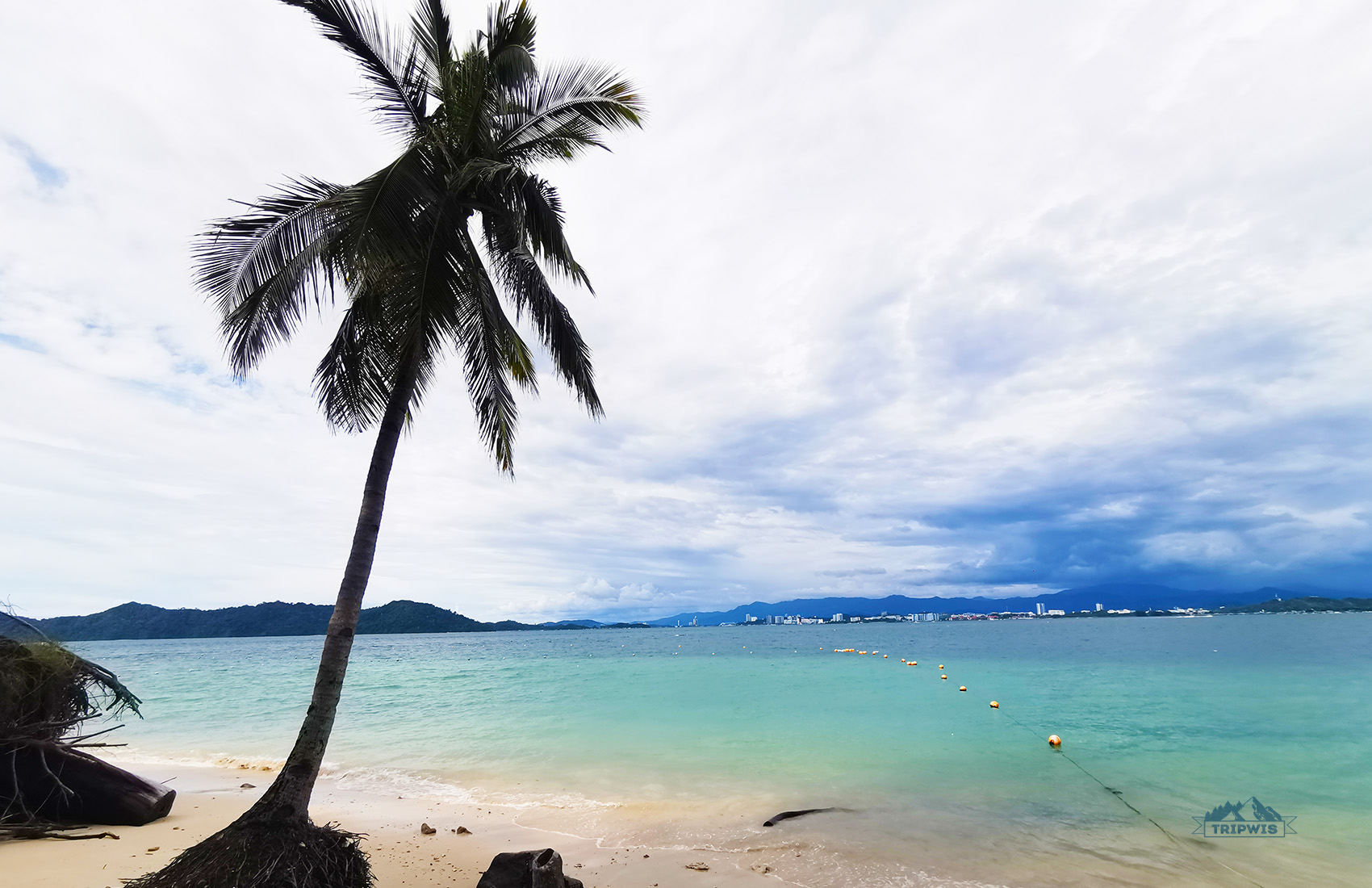
Kelambu Beach
Kudat’s region darling, it’s a beautiful remote beach that doesn’t see much crowds throughout the year. Not for its lack of “wow” factor — the natural hideaway sequestered by lush greenery and crystal-clear waters is undoubtedly impressive. The lack of high demand is due to its great distance from Kota Kinabalu — it’s a three-hour drive to the beach from the Sabah capital.
Tanjung Aru Beach
The most happening beach in the state due to its prime location — it’s about 6 km from Kota Kinabalu’s downtown. The stretch of the waterfront is quite long — around 2 km, but it doesn’t help much with the crowds. The proximity to the city, the developed infrastructure (loungers and umbrellas for rent, cafes, hotel restaurants, sports areas, and other tourist haunts), and the opportunity to watch one of the best sunsets on the island all total up to the beach being packed almost 24/7. The sand here is a little coarse, but the water is as clear as ever. Though jellyfish could make an appearance, you wouldn’t be startled by their presence in the water — beach signs usually warn of the jellyfish situation.
TUNKU ABDUL RAHMAN MARINE PARK ISLAND BEACHES (we’re still in Sabah):

Photo from Wikimedia.org
Mamutik — the smallest island in the park and the closest one to mainland. Since it’s easily reached by a speedboat, it can get a tad crowded. One side of the island features a rocky shore, while the other is a perfect white sand beach setting. You can rent masks, fins, and snorkels on the beach — the offshore reef is home to countless colorful fish for you to (respectfully) stalk. I even found a small “sardine run” situation under one of the nearest piers — though the scene wasn’t as grand as Moalboal’s iconic attraction of the same nature, the sight was still mesmerizing.
The happy encounters didn’t stop there — I spotted large monitor lizards sunning on the beach. The small island’s infrastructure is great for its size — apart from gear rentals, you can also find kiosks with bottled water and snacks, and even a simple Chinese eatery. There’s plenty of shade here too, so you will not be stranded to fend for yourself in the infamous Malaysian heat with no way to hide from it.
📍Place to stay overnight: Mamutik Island Resort (from $90 with breakfast)
Manukan — the second largest island of the park (after Gaya), its crescent-shaped body has plenty of forest eco-trails to check out when the sun’s at its peak and the beach gets too crowded. Manukan’s beaches are the most developed of the bunch (loungers, umbrellas, gear and canoe rentals, — the whole nine yards!), with great snorkeling opportunities; they proudly carry the badge of being locals-approved.
📍Place to stay overnight: Sutera Sanctuary Lodges (from $125 with breakfast)
Sapi — connected to the stately Gaya by a sandbank (that you can walk on during low tide), this tiny island does not win awards for its infrastructure — the facilities are definitely lacking here (no cafes, restaurants, showers… bring your own snacks and water if you plan to spend the day). Still, the island’s beach gets super crowded as soon as the light hits it — the snorkeling is great here. Look out for a famed mushroom-shaped coral not too far from the island’s edge — you can sometimes meet turtles here. Large schools of fish and swathes of harmless jellyfish are a constant presence — great news still, even if the chance encounter with a turtle passes you by!
📍Place to stay overnight: None
These three islands are the most popular. There’s a combo jetty ticket that allows you to visit two of them in one day ⬇️
Sulug — the furthest island from the mainland; the distance buys the needed feeling of tranquility and serenity to the isle’s sandy beach. Jungle-backed coves and castaway vibes are worth the extra time spent on the speedboat — here, you can snorkel to your heart’s content without bumping into fellow beachgoers too much in the process.
📍Place to stay overnight: None
Gaya — the largest island in the park and its main event. Long beaches, dense forest, marked trails that feature a plank-walk across a coastal mangrove, amazingly developed infrastructure (cafes and restaurants are abound here), — Gaya is a true treat for the soul.
📍Place to stay overnight: 5* Gaya Island Resort (from $215 with breakfast)
BEACHES OF BORNEO’S STATE OF SARAWAK:
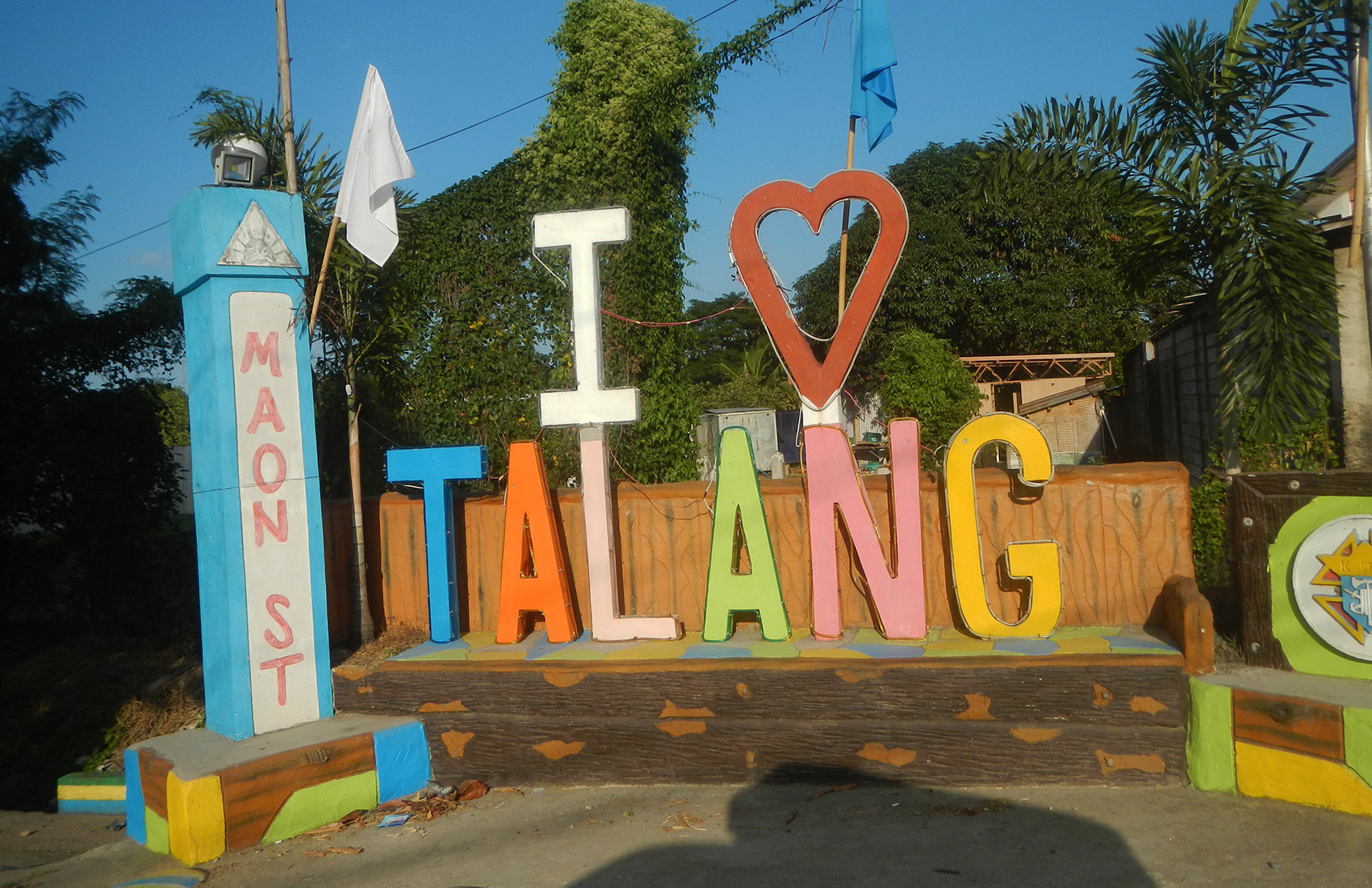
Photo from Wikimedia.org
Damai Beach
The main waterfront of Sarawak state, this beach is set within 40 km of the capital — Kuching. Nestled at the foot of Mount Santubong, framed by palms, and surrounded by glitzy beachfront resorts, Damai Beach provides a splendid sight. Watersports (kayaks, jet skis) and watching the sunset are the main events here — swimming as it is gets a back burner place, since the nearest river colors the water into a tea hue after heavy rainfall. The shallow waters are often hounded by jellyfish (and low tides are prevalent), so look out for these slimy beasts.
📍Place to stay nearby: 5* Damai Beach Resort (from $90 with breakfast)
Trombol Beach (5 MYR / $1.2 to get in)
Also known as Golden Beach, it is one of the wilder stretches of sand not too far from Kuching (a 45-minute drive will get you here from the capital of Sarawak). The sand is coarser here, but the water is simply beautiful — and this is enough to proclaim the beach a grand one. The shorefront is framed by palm and casuarina trees, and you can see the outline of Mount Santubong in the distance. Apart from the usual beach facilities (restrooms, showers, food and drink stalls), you can also find ATV rentals here — grab yourself a four-wheeled beast and zap along the shoreline with wind in your hair!
The beach can get a tad windy — but it’s not such a bad downside you might think it is. On the contrary, Trombol Beach has prime kite flying conditions. The sunsets are also quite spectacular here.
📍Place to stay nearby: None
Talang-Talang Islands (Pulau Talang Besar and Pulau Talang Kecil)
Playing quite an important role in Talang-Satang Marine National Park, these islands are set even further west from Kuching. The beaches here are Sarawak’s prime turtle conservation areas — Green and Hawksbill Turtles are the focus of the efforts. The access to the islands is restricted; you can either book an official tour to the park or take part in the volunteer program.
📍Place to stay nearby: None
How to make the most out of your beach day in Borneo:
- Come early — both island and mainland beaches get progressively more crowded during the day, so early bird gets the clearest water and more options for a beach spot!
- Bring reef-safe sunscreen and other protection from the sun (hats, glasses, long sleeve shirts) — it may take some time to notice that you’re developing a sun burn, especially if the beach is windy. It’s better to take some precautions than suffer the consequences!
- Take some cash with you — beach food stalls, gear rentals, boat tickets, parks entry fees more often than not all require cash.
- Respect the wildlife — both marine and land animals would be better off if you don’t touch or interact too closely with them. Same is true for the reefs — do not stand on them or even touch them.
- Mind the beach signs — you will be warned against anything from red tide to jellyfish and storms; be mindful of the water conditions before diving in.
- Bring an underwater camera — the biodiversity-rich reefs, schools of sardines, stately turtles and other marine life are sights worth capturing, no doubt about it!
- Pack your own snorkeling gear — if you don’t want to pay extra for renting of snorkeling equipment, you better bring your own. Some beaches have more rocky parts — to explore them, water shoes are a must.
- Grab water and snacks — not every beach has a food stall or a kiosk, so packing a lunch is the obviously essential move.
Borneo’s main sites and tours
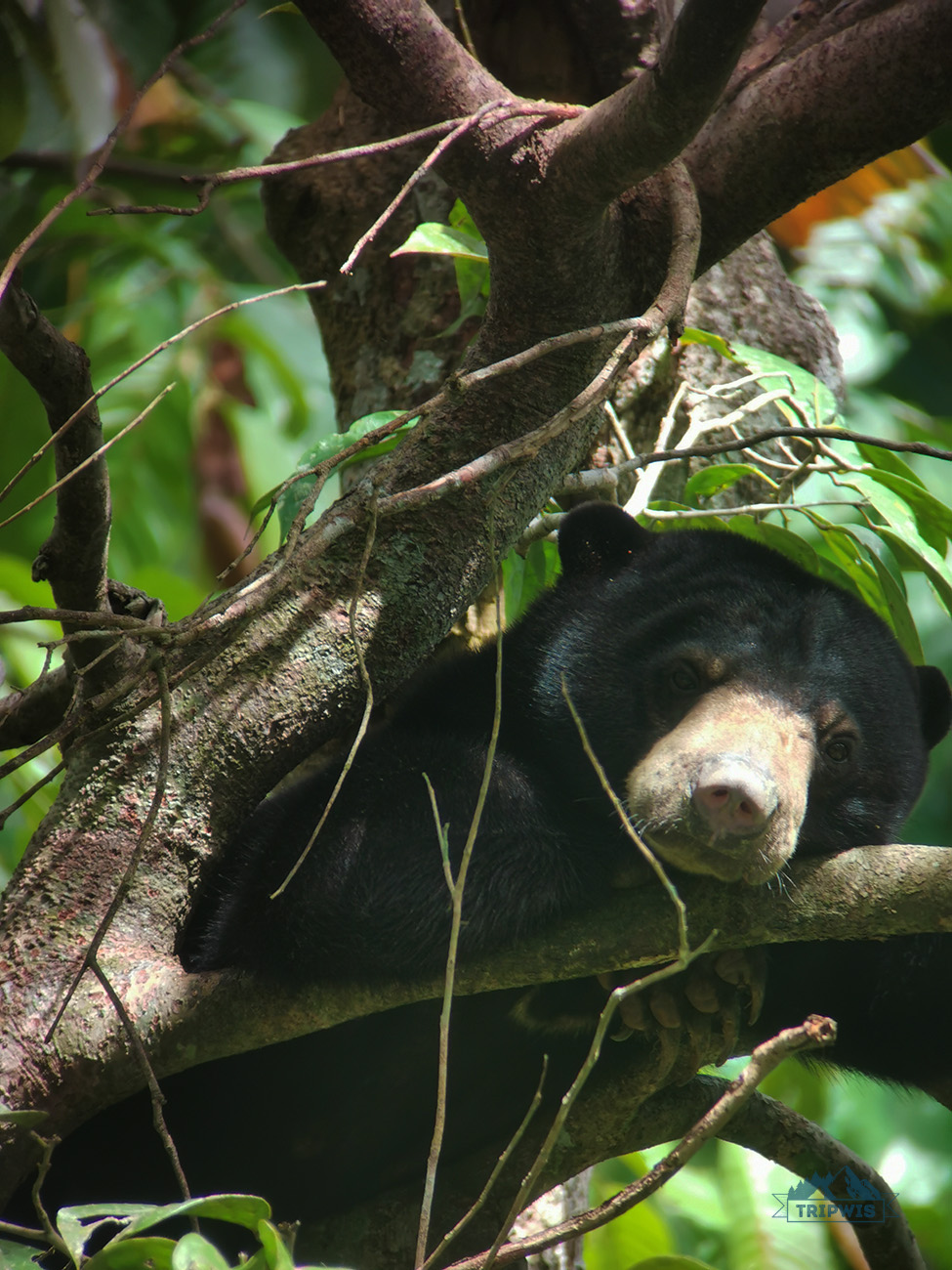 |
 |
Upon landing on the island, I’ve come to the realization that a question of what to see in Borneo is a futile one — the more pressing issue is HOW to pack everything this place has to offer into your itinerary.
I’m not going to focus on the towns of Borneo, as there isn’t much to see there apart from the beaches and the food (and there’s a separate section on the food below). For the most part, these are small industrial towns that are convenient bases for exploring the nature around them.
A classic Malaysian Borneo itinerary looks like this:
- fly into Kota Kinabalu
- spend 3-4 nights in Kota Kinabalu (the islands and the main national park)
- fly to Sandakan for 3-4 nights (orangutans, sun bears, proboscis monkeys, rainforest)
- transfer to Kinabatangan, staying for 1–2 nights (river cruises), and return to Sandakan
- fly back to Kota Kinabalu or Kuala Lumpur
A few notes on this itinerary: There are no direct flights from Sandakan to Kuching (in case that’s where you’re headed). Some travelers extend the route after Kinabatangan and continue on to Semporna (flying from Sandakan to Tawau or taking the RedBus bus that leaves at 8:00) — to relax on the beaches and go snorkeling. Since we already did that in Kota Kinabalu, we decided to skip Semporna.
If we’d had more time, I would’ve flown from Kota Kinabalu to Mulu and back — to spend two nights in Gunung Mulu National Park.
And now, let’s get into what to see on Borneo and how to fill those days you’ve set aside. I’ve divided my list based on the destinations’ locations. Enjoy!
BORNEO ATTRACTIONS NEAR KOTA KINABALU, SABAH:
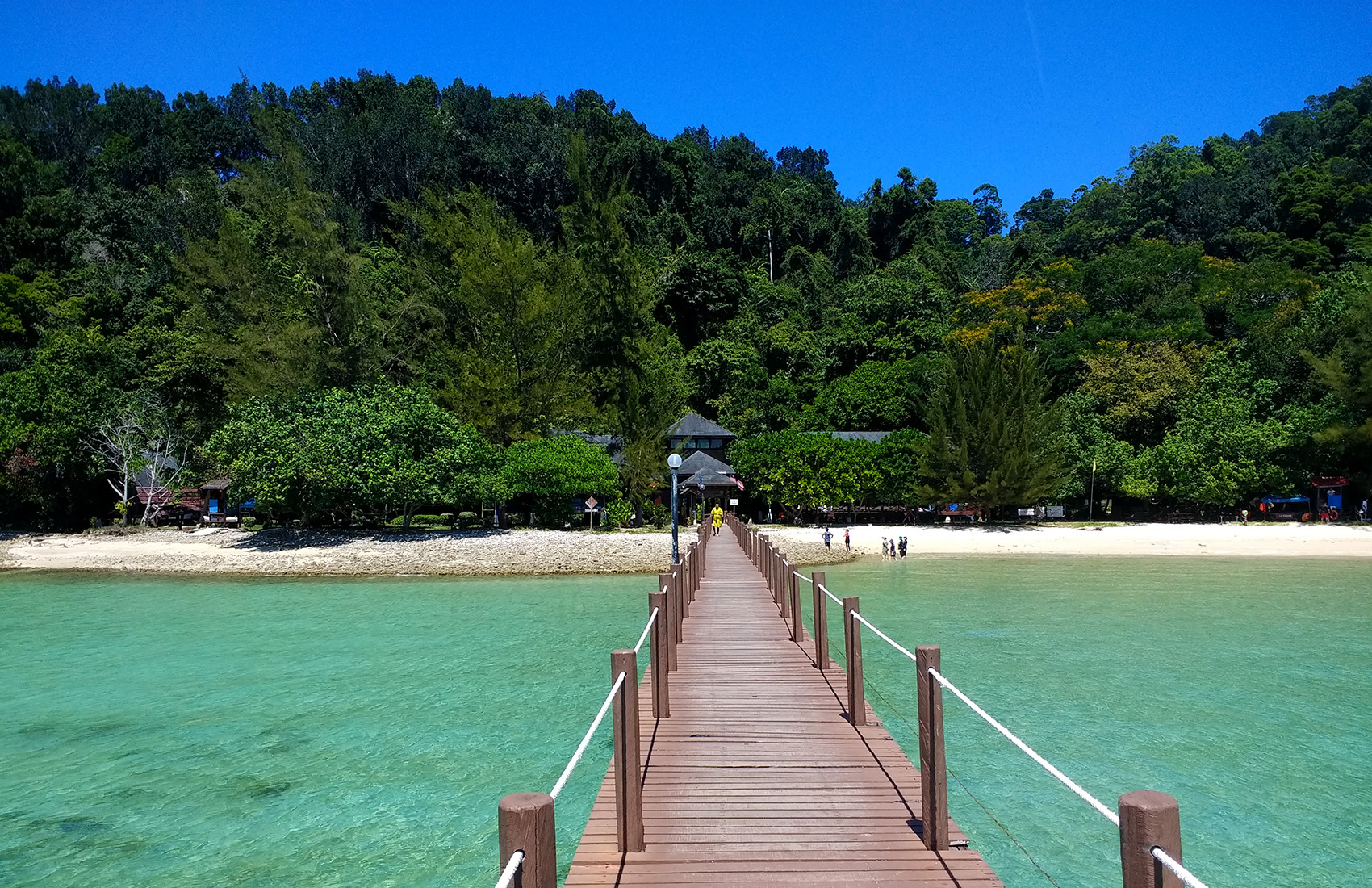
Photo from Wikimedia.org
📍 Tunku Abdul Rahman Marine Park — the aforementioned five-island sanctuary famous for its clear shallow waters, reef-clad shores, and stunning jungle-backed beaches. The closest island is a 15-minute boat ride away from the mainland, which means the park is a fan-favorite destination among Kota Kinabalu visitors. There are tours that cover all five islands, but I would recommend sticking to two or three for maximum immersion in this magical setting.
You can book this ultimate snorkeling and island-hopping experience with lunch and transfer through Trip.com ($37 per person) or Klook ($45 per person). Alternatively, buying your tickets in person at the Jesselton Point Ferry Point is possible. Come early for more options, or at noon for better deals.
Boats depart every half an hour starting from 8:30 a.m.
Tickets are 45 MYR / 55 MYR / 65 MYR / 75 MYR ($11–$18) depending on the number of the islands you want to visit + 25 MYR ($6) for conservation fee
📍 Kiulu River Park and Padas River (1-2 hour away from Kota Kinabalu) — moving away from the waterfront but not the water! Kiulu River Park is a prime Borneo destination for first-time white water rafters. Kiulu River rapids are classified as Class I–II, which means they’re beginner- and family-friendly. The rafting here is more fun after heavy rainfall, as the river is fuller, the rapids grow stronger, and the shrubs lining the banks get super green, almost emerald in color.
Padas River is where you come in Borneo if you’re an experienced white water rafter. With around eight rapids of Class III–IV, tons of crazy whirlpools and bumps, and adrenaline-inducing drama of the river flow itself, Padas is not for the faint-hearted. The activity starting point can only be accessed by a train ride (a scenic 2-hour journey in a vintage-looking train through the island’s scenic countryside), strong swimming abilities are recommended for the brave participants
The Kiulu River Park tour is around $40–$45 per person; the best deal is this one on Klook
📍 Mari Mari Cultural Village (40 minutes away from Kota Kinabalu) — a living museum experience. Coming here means diving headfirst into the traditions of five local ethnic groups, hearing their stories, watching live demonstrations and performances, and tasting the traditional snacks. The whole shebang doesn’t feel kitschy in the slightest (like such things tend to feel; loads of people dressed in traditional clothes and performing the same old rituals for the sake of performance — Mari Mari has none of that, it is the real deal!). The hands-on approach will titillate even the most uninterested of tourists — you can try blowing into a Murut blowpipe at a target and watch the bamboo fire-starting demo from super close.
Booking a tour is mandatory to being able to explore Mari Mari Village ($32 per person)
📍 Kinabalu Park (3 hours away from Kota Kinabalu) — the first-ever UNESCO World Heritage Site in Malaysia, the park is home to Borneo’s natural crown — Mount Kinabalu (4,095 meters above sea level, which is proclaimed to be the highest peak of South Eastern Asia). A two-day trail to the summit is often taken by experienced hikers while regular travelers explore the park’s grounds.
There is a seemingly endless variety of exotic flora and fauna. The world’s largest flower — Rafflesia, also known as corpse flower due to its particular smell — can be found blooming here from October to May). Expect long hours spent trekking the trails and admiring the different forest zones up at 1,600 meters. The misty paths are a sight to behold, but Kinabalu has so much more in store — Poring Hot Springs, for one, is a destination to write home about (a relaxing dip in hot sulfur water will make any stress left over in your body dissipate within seconds).
Most tours add a few more stops to the experience: Desa Cattle Dairy Farm and Kundasang Market, among others.
Book the tour in advance via Klook (from $50 per person). Extra fees include admissions to the park itself (50 MYR / $12), dairy farm (5 MYR / $1.2), and hot springs (50 MYR / $12)
BORNEO ATTRACTIONS NEAR SANDAKAN, SABAH:
 |
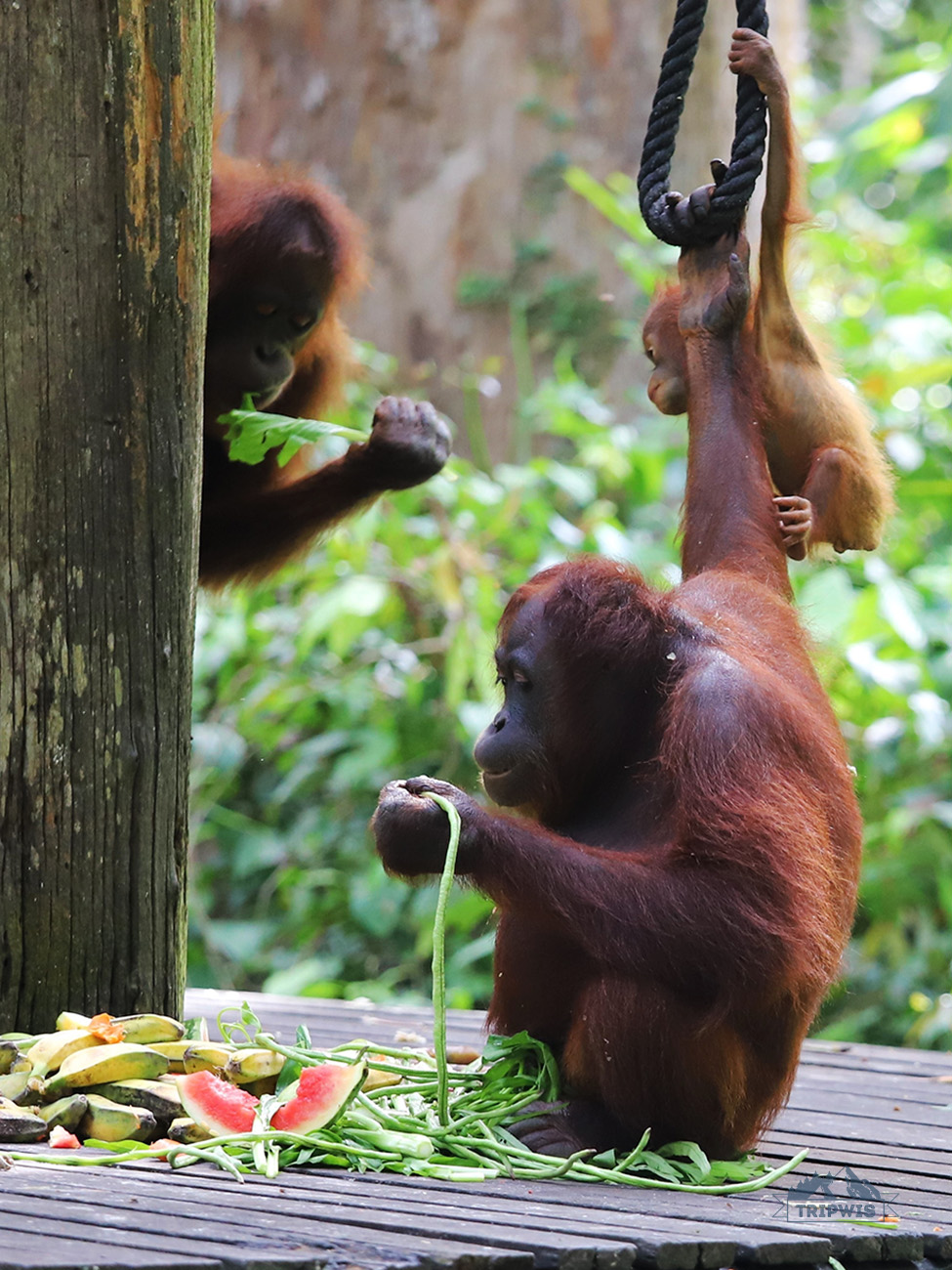 |
We used a night bus from Kota Kinabalu to Sandakan — it took us 7 hours and cost 46 MYR / $11.1 per person; the flight is $20.
📍 Sepilok Orangutan Rehabilitation Centre (20 minutes away from Sandakan) — arguably the most popular destination in Borneo for animal lovers! This rehabilitation center is doing the god’s work by helping orphaned or injured orangutans learn the art of being wild again.
If you search “Where to see orangutans in Borneo”, Sepilok will be the first result (though you can meet these fascinating creatures anywhere in the wild here). Make sure to visit the nursery and watch the tiny babies from the viewing area behind the glass, or drop in on the semi-wild adult feedings at 10 a.m. and 3 p.m. — both activities will make you lose track of time, that’s a guarantee!
The center’s entry fee is 30 MYR / $7.25 (if you have a camera and want to take photos, it will cost you additional 10 MYR / $2.4)
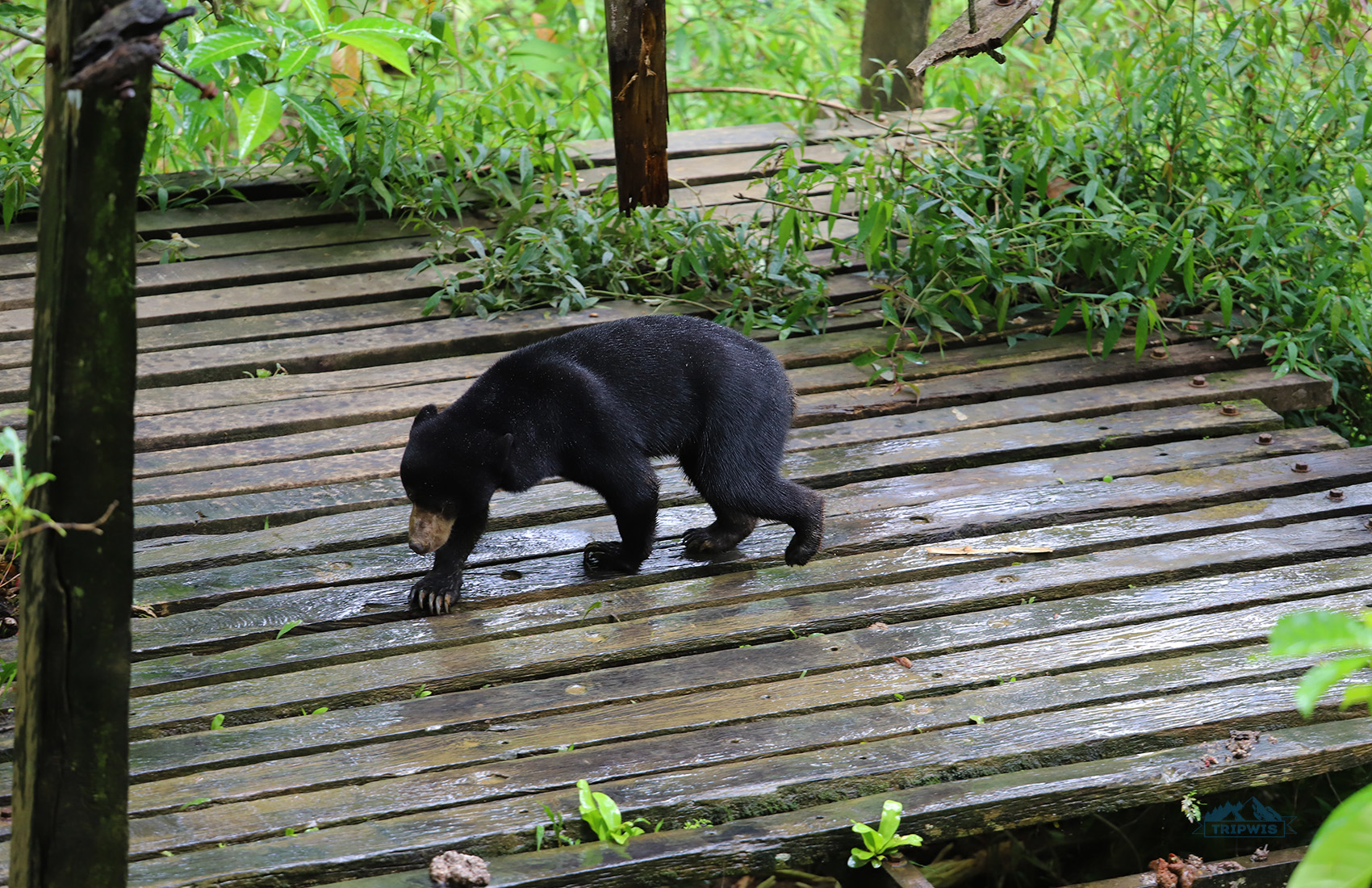
📍 Bornean Sun Bear Conservation Center (20 minutes away from Sandakan) — located right next door to Sepilok, this conservation center is focused on rescuing the world’s smallest bear — Sun Bear.
If you haven’t heard about the species before, I have a few fun facts: These cute munchkins’ cream-colored chest patches (where their name comes from) are as individual as fingerprints are for humans, they have super long tongues (to search for honey, Winnie the Pooh is majorly lacking in this regard) and powerful limbs to climb on trees — they often sleep in the crowns. Sun Bears are also the shyest bears, and they’re primarily nocturnal — both facts mean that it will be harder to spot them inside the conservation center area. Come mid-morning for higher probability of a sighting; the signage and facilities here are great for self-guided learning.
A half an hour is more than enough to explore the center; the entry fee for adults is 50 MYR / $12 and 25 MYR / $6 for children
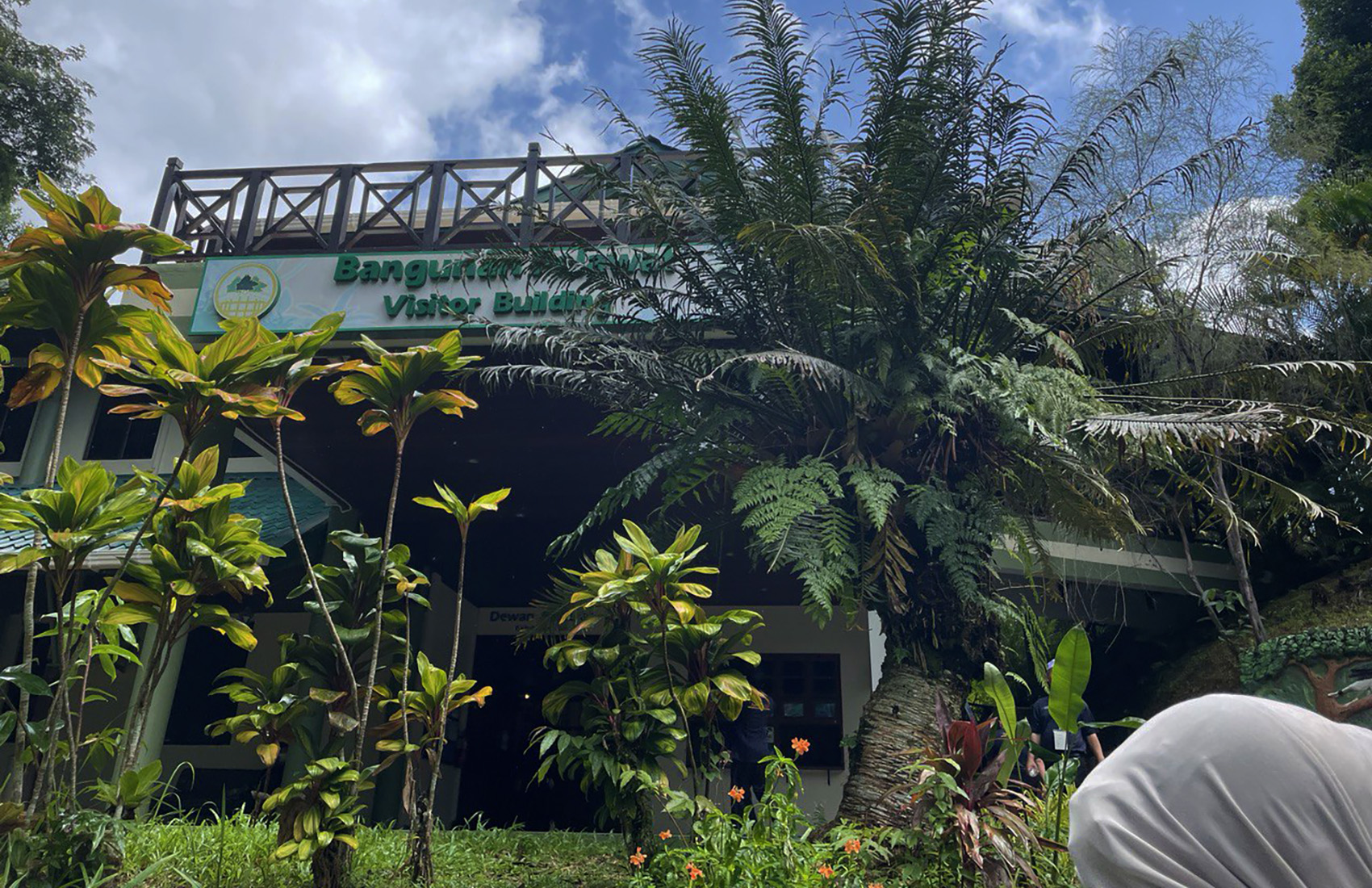
Photo from Wikimedia.org
📍 Rainforest Discovery Center (RDC) (20 minutes away from Sandakan) — a nature reserve with a mission of educating the masses about Borneo’s rainforests and the threats they face on the daily (human- and climate-centric). The center is home to lush grounds crisscrossed with trails and canopy walkways, and a garden with a lake, — you could potentially stop here, but the local fauna takes the experience up a notch.
Come here for birdwatching — endemic species of Borneo Bristlehead and Whitehead’s Broadbill are the birds to look out for, since it’s one of the few places on the island to see these beautiful creatures! Another intriguing option is a guided night walk to spot some scorpions, tarantulas, and snakes. Wear long sleeves — the rainforest is home to hoards of mosquitos and other annoying gnats.
Rainforest Discovery Center entry fee is 30 MYR / $7.25
Side note: You can combine all three of Sandakan’s aforementioned attractions into one tour ($125) — bookable through Viator for convenience.
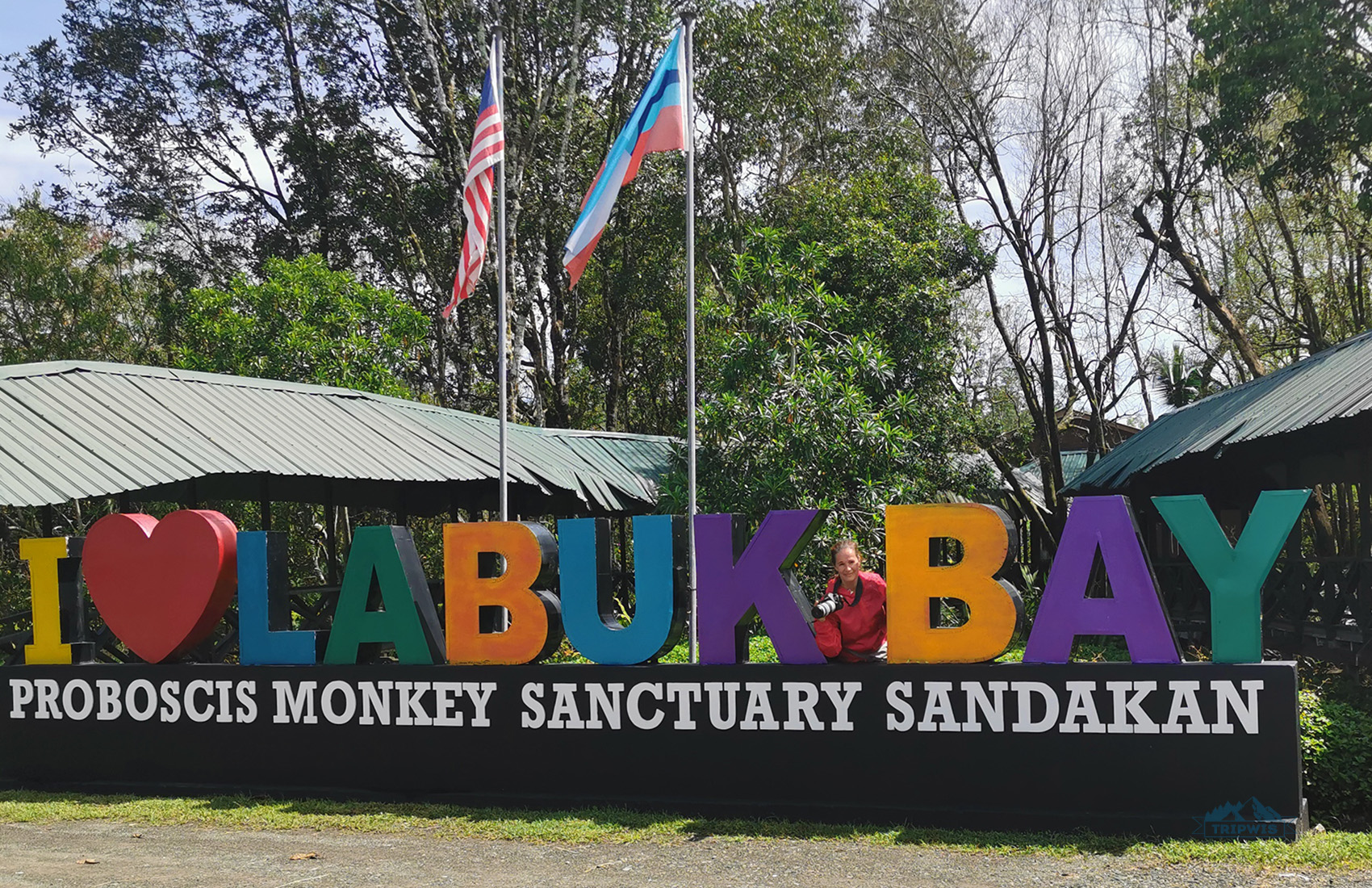
📍 Labuk Bay Proboscis Monkey Sanctuary (45 minutes away from Sandakan) — a private-owned sanctuary based in mangroves (currently being replanted over oil palm plantations, which is pretty awesome!) that is home to over 300 of proboscis monkeys and a few other exciting creatures — silvered leaf monkeys and hornbills, among others.
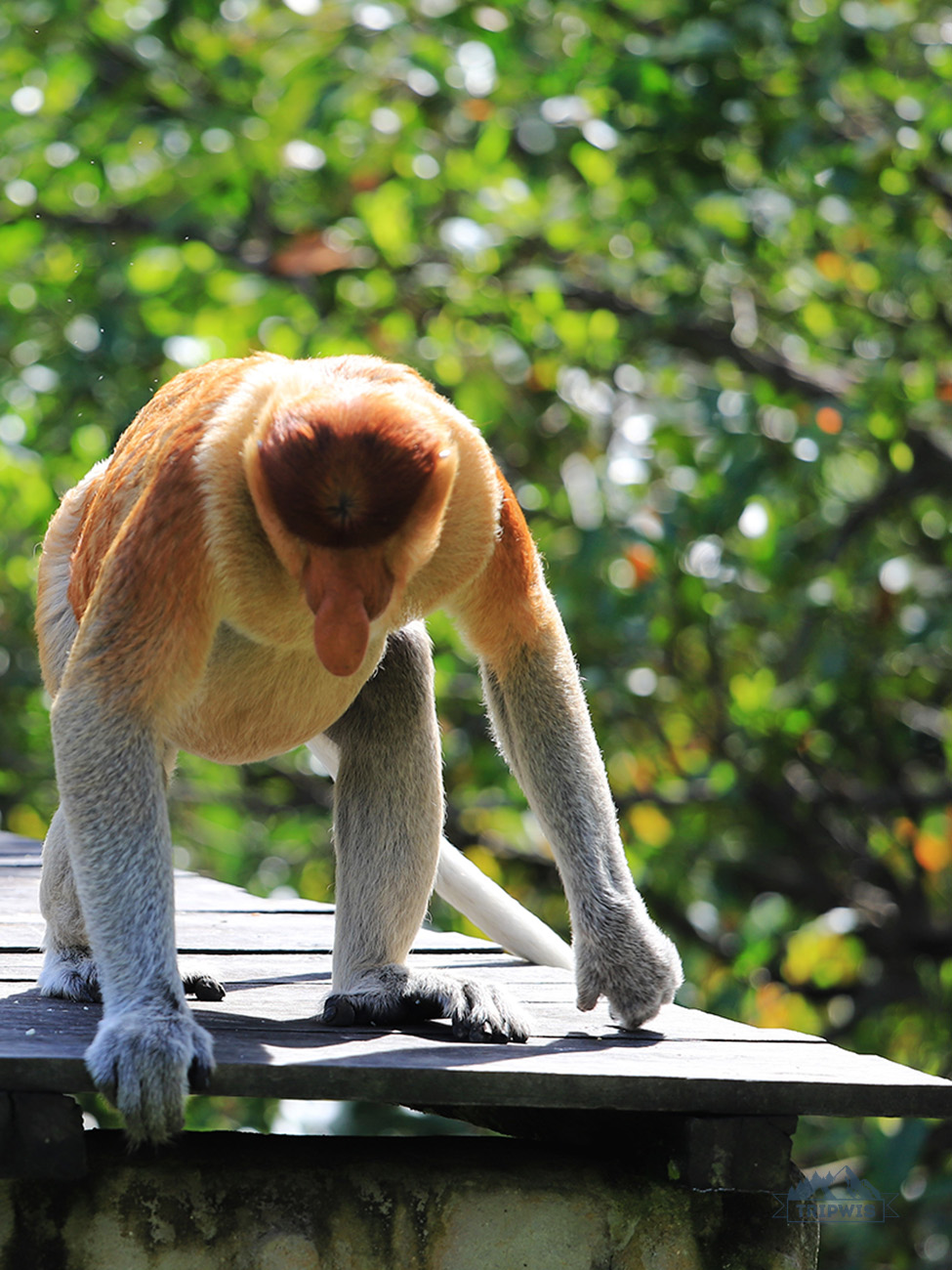 |
 |
The stars of the show — the monkeys — have arguably the weirdest look to them. Their long bulbous noses and large potbellies will for sure lead to stifled laughter in the crowd (though the noses have a practical reason — they amplify the male’s calls that attract the females). The sightings at the sanctuary are time-honored; the monkeys get lured with food at feeding times. There are two platforms, and two feedings scheduled for each, one in late morning and one in mid-afternoon.
Entry fee to the sanctuary is 60 MYR / $14.5
📍 Kinabatangan Wildlife Sanctuary (3 hours away from Sandakan) — a wonderful nature reserve tucked away further into the Borneo rainforest. Kinabatangan river cruise is the activity that often finds its way into traveler’s bucket-list Borneo itineraries — after all, the river can only be described as the island’s wildlife superhighway. As you sit back in the boat, scan the river, the banks, as well as the tree tops for signs of life. You can expect to see pygmy elephants, proboscis monkeys, crocs, hornbills, and even orangutans living their wild lives in the sanctuary.
Best way to explore Kinabatangan is staying for 1-2 nights nearby — for example, in Sukau — and book the cruises at the hotel/lodge you choose
BORNEO ATTRACTIONS IN SARAWAK:
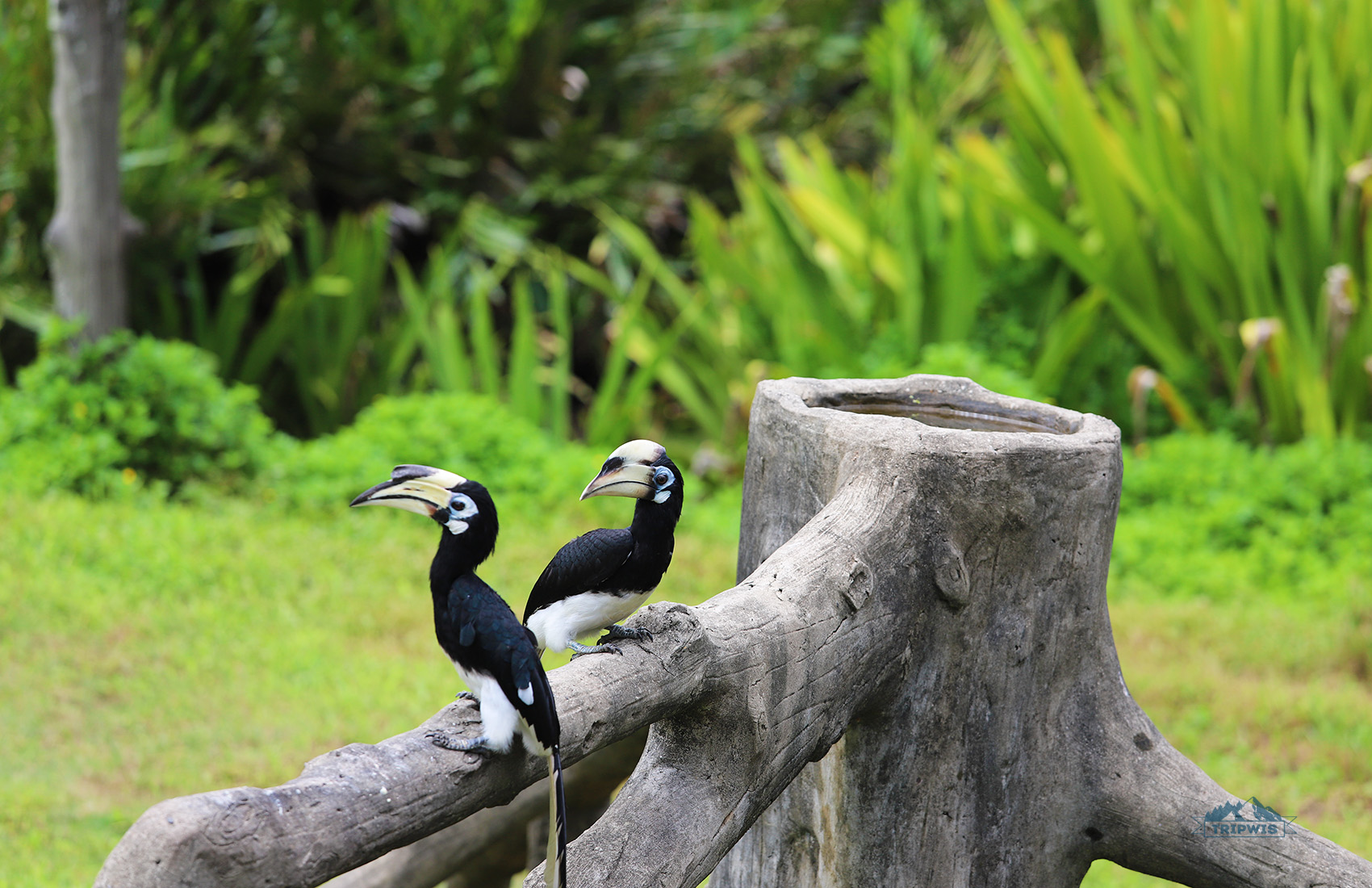
📍 Niah National Park — home to the world-famous Niah Painted Caves, the park draws travelers into the lesser-developed Sarawak territory. The cave complex has wall paintings that attest to humans living here some 50,000 years ago, which makes it an important historical (and natural) destination. Walk along the shaded trails and look out for bats and swiftlets as you duck into the cave openings — the dark ceilings of the caves are home to thousands of them!
Park entry (includes access to the caves) is 20 MYR / $4.85
📍 Gunung Mulu National Park — it seems like Sarawak’s tourist attractions are all based around cave systems, and Gunung Mulu Park is no exception! It’s a UNESCO World Heritage Site that is famed for razor-sharp limestone pinnacles, a large Deer Cave filled with millions of bats, and unique rainforest ecosystem. The gem of the park is the world’s largest cave, Sarawak, but it’s so hard to reach (you’ll literally need to make your way through neck-deep water underground!) that Deer Cave gets all the attention with its 148-meter height.
The park’s remote location is something to keep in mind — it’s impossible to reach it by land, so you have to rely on domestic flights from Kota Kinabalu, Kuching, or Miri into Mulu Airport. Probably that’s why it feels like the most authentic part of Borneo you’ll ever find! Another important thing to know is that you need a guide for almost every spot in the park (except for the bats observatory area).
When I was planning our itinerary, I set on booking a Deer & Lang caves tour (35 MYR / $8.5 per person). It starts at 2 p.m., lasts for 3 hours, and includes Bat Exodus — a nightly routine where all the bats leave the caves and fly around in beautiful formations before going off into the rainforest in search of food. You can watch it for free if you walk up to the bats observatory area from 5p.m. to 6:30 p.m.
As I mentioned, stay at 5* Mulu Marriott Resort & Spa, if you can (there are only two hotels anyway) — it’s my dream hotel, where you’re literally a guest of the jungle while still wrapped in all the comfort of a Marriott.
Side note: If you want to see the orangutans, Kuching has its own rehabilitation center — Semenggoh Wildlife Center.
OTHER NOTABLE BORNEO SITES (SABAH):

📍 Sipadan Island — located off the east coast of Sabah, the island is one of the best dive sites in the world (according to weathered divers). The composition of the isle alone is impressive — a giant coral reef is nestled atop an old volcano that protrudes from the sea floor for 600 meters!
The abundance of marine life here is truly like nothing you’ve seen before — turtles, barracuda, parrotfish, and other aquatic residents of Borneo shores haunt the reef with impressive regularity. You can even see an occasional hammerhead shark — bucket list experience for many diving enthusiasts. In order to preserve the island in its most pristine form, Malaysian government issues a limited number of Sipadan permits for visitors. In order to get one, you have to use one of the nearby resorts (on Mabul or Kapalai), stay there a minimum number of nights that guarantee a permit, and then make use of the package transfers to and from the island. All the hoop jumping is worth it in the end, trust us!
📍 Bongawan Mangrove Cruise — yet another river cruise through the lush mangroves that is full of animal sightings (proboscis monkeys and macaques are the stars of the show; don’t look the latter in the eyes — it’s a sign of aggression!).
However, Bongawan cruise has a few Jokers up its sleeve that set the site apart from the others that are similar to it: While on the cruise, you will visit a place called Sky Mirror Beach to take the iconic photo of yourself standing on what could only be described as a mirror reflection of the sky. After sunset, your boat will traverse under the trees lit up by millions of fireflies. Your day will not be complete without a traditional Malay-style buffet that perfectly complements the activities listed above.
Make sure to get your ticket in advance — Klook often has great deals on this cruise
📍 Danum Valley Conservation Area — a super old (130-million-year-old, to be exact) rainforest with tons of trails used for trekking inside it. It is one of Borneo’s wildest places — here, you’re deeply immersed into the forest, walking paw-in-paw with its other inhabitants. Rare animal sightings here include wild orangutans, gibbons, and even leopards (though the big cats are great at blending in, so don’t get your hopes up!).
Though there is a separate conservation fee of 50 MYR / $12 per person you need to keep in mind, most visitors decide to get package deals — these usually include transfers, accommodation, guided activities, and meals.
The prices vary, but plan to spend at least 3,000 MYR / $725 for a three-day two-night stay
📍 Deramakot Forest Reserve — often described as a “sustainable forestry” (so some logging is still taking place), this forest reserve is one of the best destinations for night safaris in Borneo. The biodiversity here does not lose much to Danum Valley — in fact, you have higher chances of seeing a marbled cat or a clouded leopard in the wild here than anywhere else in Borneo.
Animal sightings at Dermakot also include pygmy elephants and orangutans — the famed island darlings. When making a choice of Danum Valley vs Deramakot, keep in mind that Danum Valley is more about on-foot exploration, while Deramakot leans more into night drives in a 4×4.
The prices for packages vary greatly at Dermakot, but the most basic package with a 3-day 2-night stay will cost you on average 3,900 MYR / $945
Borneo cuisine and prices
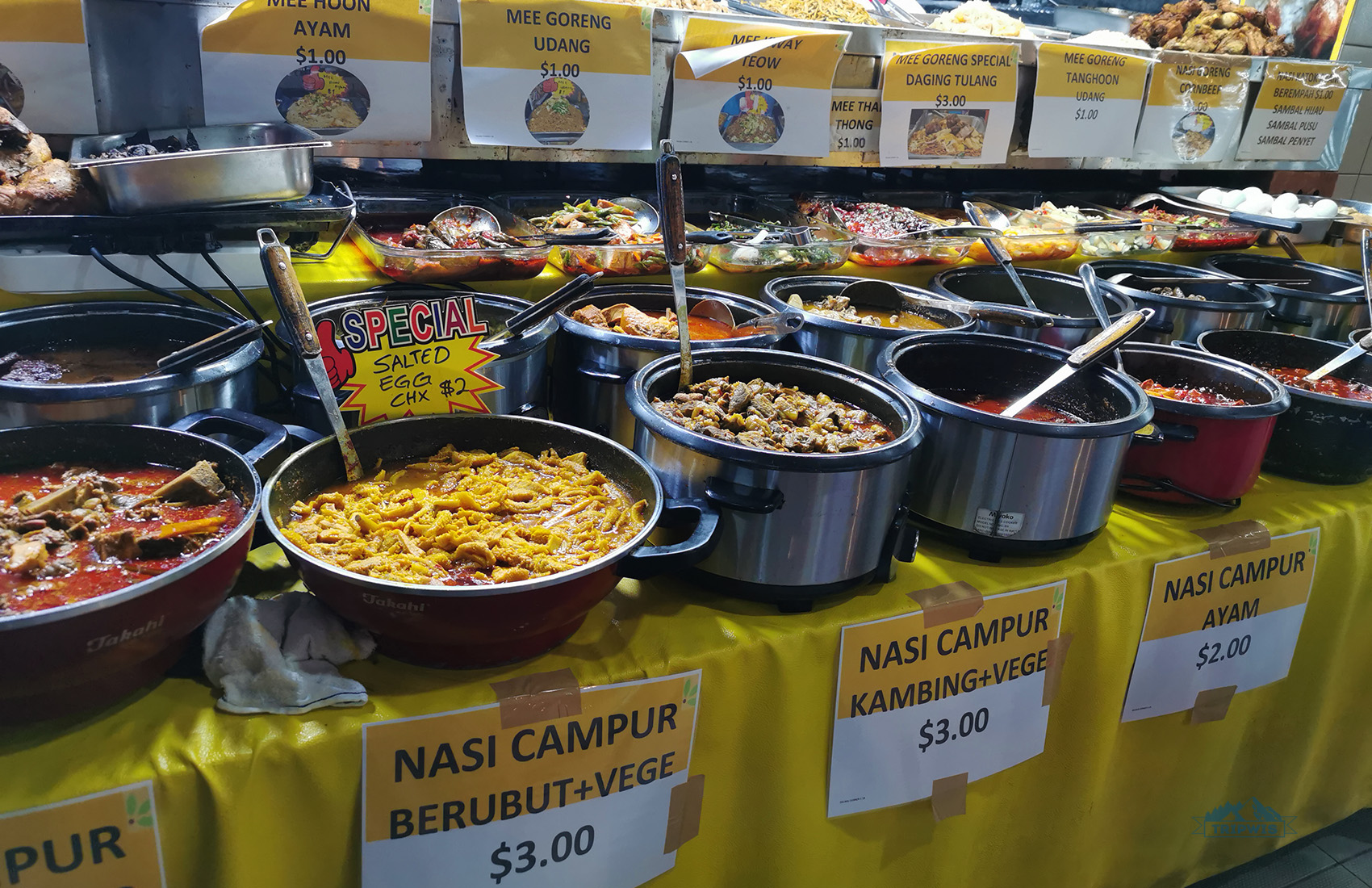
There is not one single dish that Borneo is single-handedly famous for, food-wise, but rather the state of local cuisine — often described as a melting pot of Malay, Chinese, Indonesian, Thai, Filipino, and indigenous tribal food influences.
Borneo’s cuisine is a friendly gateway for European palates into some of the more adventurous Asian gastronomy. Here, the food pairings may be unexpected, but you can always find a dish that will match your taste*.
*If you don’t do well with heat, ask for the “not spicy” versions of popular dishes — say Tidak pedas when you order.
Though lacking the signature dish, Borneo has plenty of the foods you absolutely must try while on the island. The category of not spicy dishes includes:
- Popiah (or spring rolls) — vegetables, fish, and even meat stuffed inside rice wrappers (we usually ordered an assortment of fillings, to satisfy all the cravings at once)
- Dim Sum — bite-sized dumplings with the fillings that run the gamut from guilt-free veggies to prawn and chicken varieties
- Satay — the quintessential Malaysian street food; it’s skewered and charcoal-grilled meat served with a sauce (which can be spicy, you’ve been warned!)
If you’re flirting with spice, then these dishes are must-orders in Borneo:
- Laksa — noodle soup with coconut milk-based curry and a variety of toppings (egg, meat, seafood, veggies). This is the dish lauded by Anthony Bourdain when he visited Borneo — and this is the late professional whose advice I trust a hundred percent
- Nasi Lemak — the iconic Malaysian dish that is comprised of rice cooked in coconut milk and pandan leaf, garnished with fried anchovies, roasted peanuts, cucumber, eggs, and spicy fried chicken or beef
When it comes to the question of where to try these dishes in Borneo, the options are endless: Tiny cafes, mall booths, street food stalls, night markets, buffets, food courts, lavish restaurants, — the choice is yours depending on your want-to-trys and budget. What I can advise for sure is the way to find the best eateries — look for long lines, they’re the local Michelin guides!
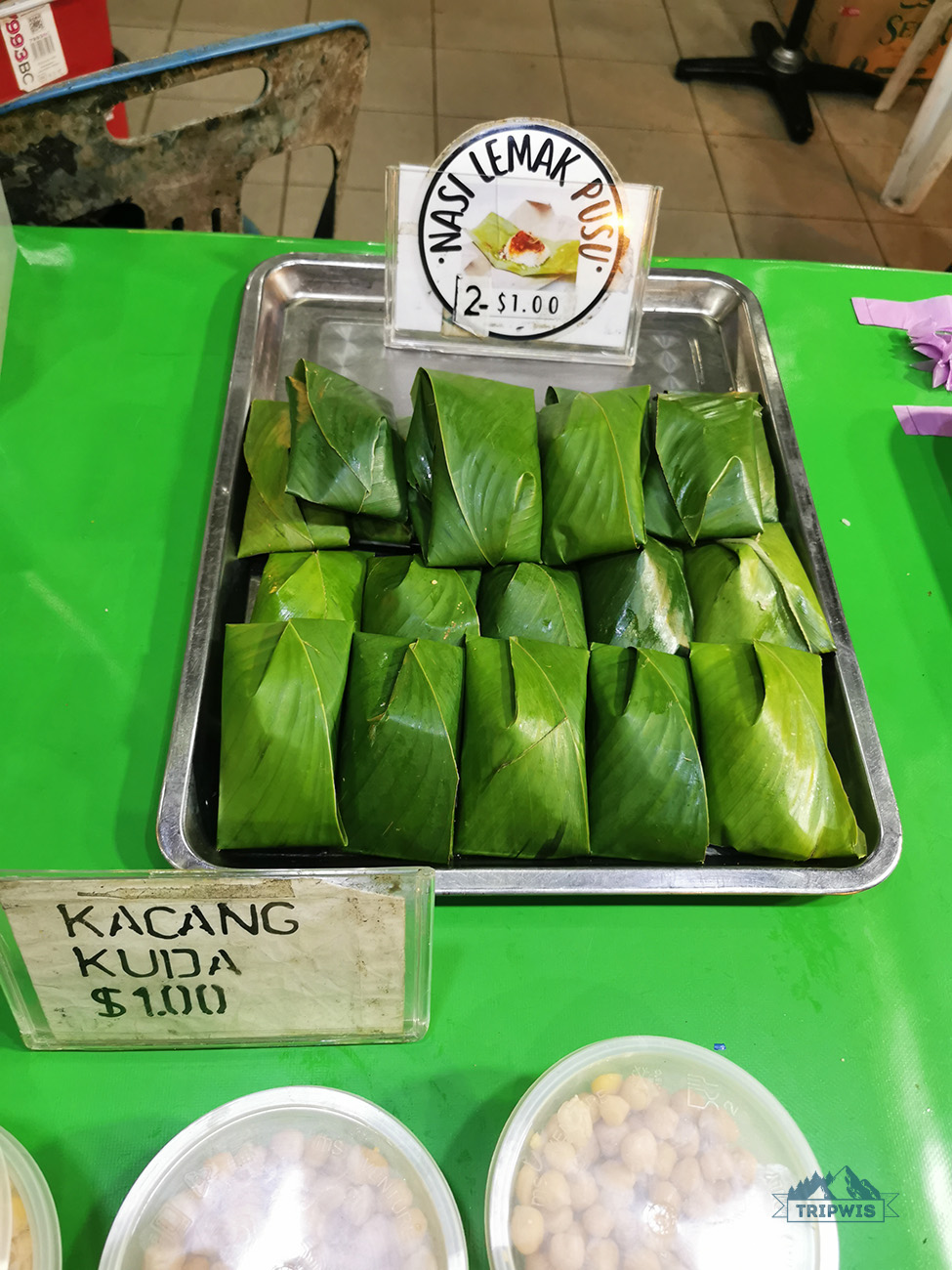 |
 |
The majority of people on Borneo island are Muslim. However, this is mostly true when referring to the Indonesian part of it and also Brunei. Our focused land — Malaysian states of Sabah and Sarawak — are more religiously diverse. What does it mean? When it comes to purchasing alcohol, there could be some restrictions put in place in a more Muslim-dominant Sabah than Christian-dominant Sarawak. Apart from that, expect higher prices on alcohol and fewer establishments to get it from (licensed hotels, bars, restaurants, and a handful of stores to choose from).
When it comes to prices, it’s safe to say that a pendulum can and does swing both ways here. Traditional dishes at local haunts will not empty your pockets in the slightest, but splashier restaurants definitely will.
Side note: Malaysia’s national currency is the Malaysian ringgit (MYR). USD to MYR conversion rate is $1 to 4.14 MYR at the time of writing.
A no-fuss dinner at a budget spot will cost you between 15 MYR ($3.6) and 30 MYR ($7.25) on average, while mid-range restaurant dinner can set you back at least 30 MYR ($7.25) to 70 MYR ($17).
For a taste of authentic dishes, go to the local fish market — pick out something from the fresh catch and they’ll have it cooked for you right then and there. Though truly chaotic, it is a more budget-friendly and definitely a more bona fide experience than a stuffy restaurant that leans more Western.
If you crave simple ingredients, then a convenience store will have your back on the island. The 7-Eleven and Orange chains are present here, and the prices for the goods that are not imported are pretty reasonable.
- Water (1.5 L) — 1.5–4 MYR ($0.35–$1)
- Beer (0.5 L) — 10–15 MYR ($2.4–$3.6) in convenience stores; 20–35 MYR ($4.85–$8.45) in bars
- Bottle of wine — from 60 MYR / $14.5
- Loaf of bread — 3–6 MYR ($0.7–$1.45)
- Cheese (200 g) — 10–20 MYR ($2.4–$4.85)
- Milk (1 L) — 6–8 MYR ($1.45–$1.95; UHT milk is more common, fresh milk is more expensive)
- Bananas (1 kg) — 3–5 MYR ($0.7–$1.2)
- Mangoes (1 kg) — 8–15 MYR ($1.95–$3.6)
- Apples (1 kg) — 7–10 MYR ($1.7–$2.4)
- Tomatoes (1 kg) — 5–7 MYR ($1.2–$1.7)
A few notes about Brunei
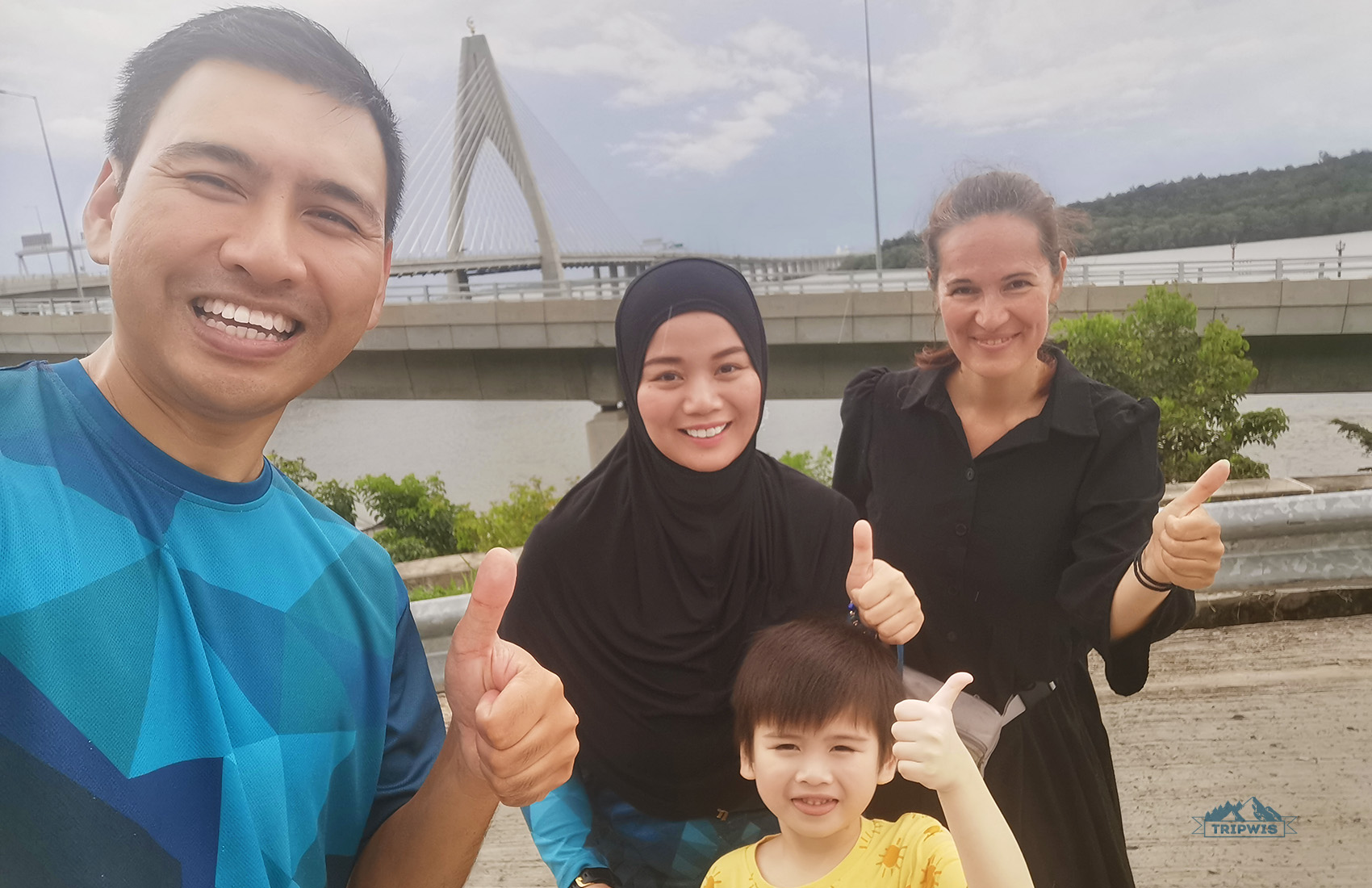
Located on the northwestern coast of the island of Borneo, this teeny-tiny country surprises most travelers with its status — Brunei is one of the wealthiest nations per capita in the world (it’s all oil and gas money).
We didn’t plan on coming here initially, but a direct flight from Kuala Lumpur was pretty affordable (and our 7-day Borneo itinerary left us with a couple of days to spare), so we took the plunge, coming to the Malay Islamic monarchy with a Sultan as its sole ruler.
Truth be told, the country of Brunei deserves an entire write-up due to its unusual (to the rest of the world) ways. Yes, it seems like a great place to be a citizen of: There’s free education and healthcare, and the majority of people living here are wealthy, having multiple cars per family. However, there are a lot of cons to Brunei as well — the prices for everything are outrageously expensive, alcohol is prohibited (you can only drink inside your hotel room, in private), public Christmas displays are banned (you can still celebrate at home, behind closed doors), and homosexuality is punishable by 10 years (!) in prison.

All in all, our detour wasn’t a lengthy one, though learning more about the country is certainly a great idea. During our short time in Bandar Seri Begawan — Brunei’s capital — we saw:
- Omar Ali Saifuddien Mosque — also known as Brunei’s Golden Mosque, this is a striking place of worship that has become the prime symbol of the country’s Islamic faith. The mosque is often compared to the Sheik Zayed Mosque in Abu Dhabi and the Blue Mosque in Istanbul — it is THAT beautiful.
- Kampong Ayer — Brunei’s famed water village that is built on stilts above the Brunei River. Much like Buli Sim Sim Water Village in Borneo’s Sabah, it is a unique tourist attraction worthy of seeing at least once.
- Jame’ Asr Hassanil Bolkiah Mosque — Brunei’s largest mosque that features 29 domes and 29 minarets (a nod to the ruler it is named after — the 29th Sultan of Brunei, Hassanal Bolkiah). A mesmerizing sight!
- Temburong Bridge — one of the world’s longest sea bridges (it’s 30 km long) that connects Brunei’s capital and Temburong district.
FAQ and our tips for visiting Borneo

Though I have made it a point to answer the most pressing questions about traveling to Borneo throughout the article, it is the nuanced concerns that we most often see people searching for online. I hope that this list covers most, if not all, of them!
Is Borneo safe for solo travelers?
It is reasonable to assume that it is. Even solo female travelers point out a relative ease when navigating around Sabah and Sarawak. However, Borneo nature may be dangerous at times — avoid hiking alone after dark, and always keep an eye out for beach signage (red tide or storm, it all could end badly).
What’s the best month to visit Borneo for wildlife?
Borneo is a year-round destination, and its wildlife follows the same strategy (after all, sun bears don’t hibernate, and neither do the rest of the endemic species). Dry season in Borneo offers better conditions for exploring the animals’ nature habitats, but rainy season means fewer tourists — the creatures may feel more comfortable coming out of hiding during this time.
How to get to Borneo from Kuala Lumpur/Singapore cheaply?
Search for deals on budget airline flights (AirAsia, for instance) on Trip.com and get your tickets weeks in advance for better rates.
Do I need a 4×4 in Sabah/Sarawak?
If you’re planning to drive yourself to more remote destinations, then yes. However, I would discourage you from doing so during rainy season — the roads become practically non-existent, so much so that even experienced local drivers in high-clearance vehicles have trouble traversing the most treacherous of stretches. Either way, you can always arrange a transfer — to get to Danum Valley Conservation Area, for example, you first fly into Lahad Datu Airport, and then take a pre-arranged transfer (in a 4×4, we’ll give you that) to the conservation area.
Can you visit Sipadan without a permit? How to get one?
No, you cannot visit Sipadan without a permit. The limited number of permits are allotted to a handful of dive operators — in order to qualify for one, you have to book a package deal with one of the operators based in Mabul or Kapalai (with a set number of nights you must spend there).
Are there leeches in Borneo? How to prevent bites?
Yes, there are leeches in Borneo. They are mostly present on wet trails in the rainforest. You can easily prevent bites by wearing leech socks, tucking your pants in, wearing long sleeve shirts, and spraying boots and socks with DEET repellent.
How much does a Borneo trip cost (per day/per person)?
You can do Borneo for cheap, but you won’t necessarily get the full effect of the island — a budget traveler that stays at a hostel, eats mainly street food, takes a bus and not a taxi, and focuses on low-cost or free activities, will still spend at least $35–$50 a day in Borneo (this is not accounting for the cost of getting to the island — you saw how expensive plane tickets can be).
If you add an organized tour or two and change a dormitory-style room into a more comfortable option, then shoot to spend at least $100 a day. After this, the sky is the limit — diving packages and Danum/Deramakot stays rack up quite the bill!
How many days is enough in Borneo?
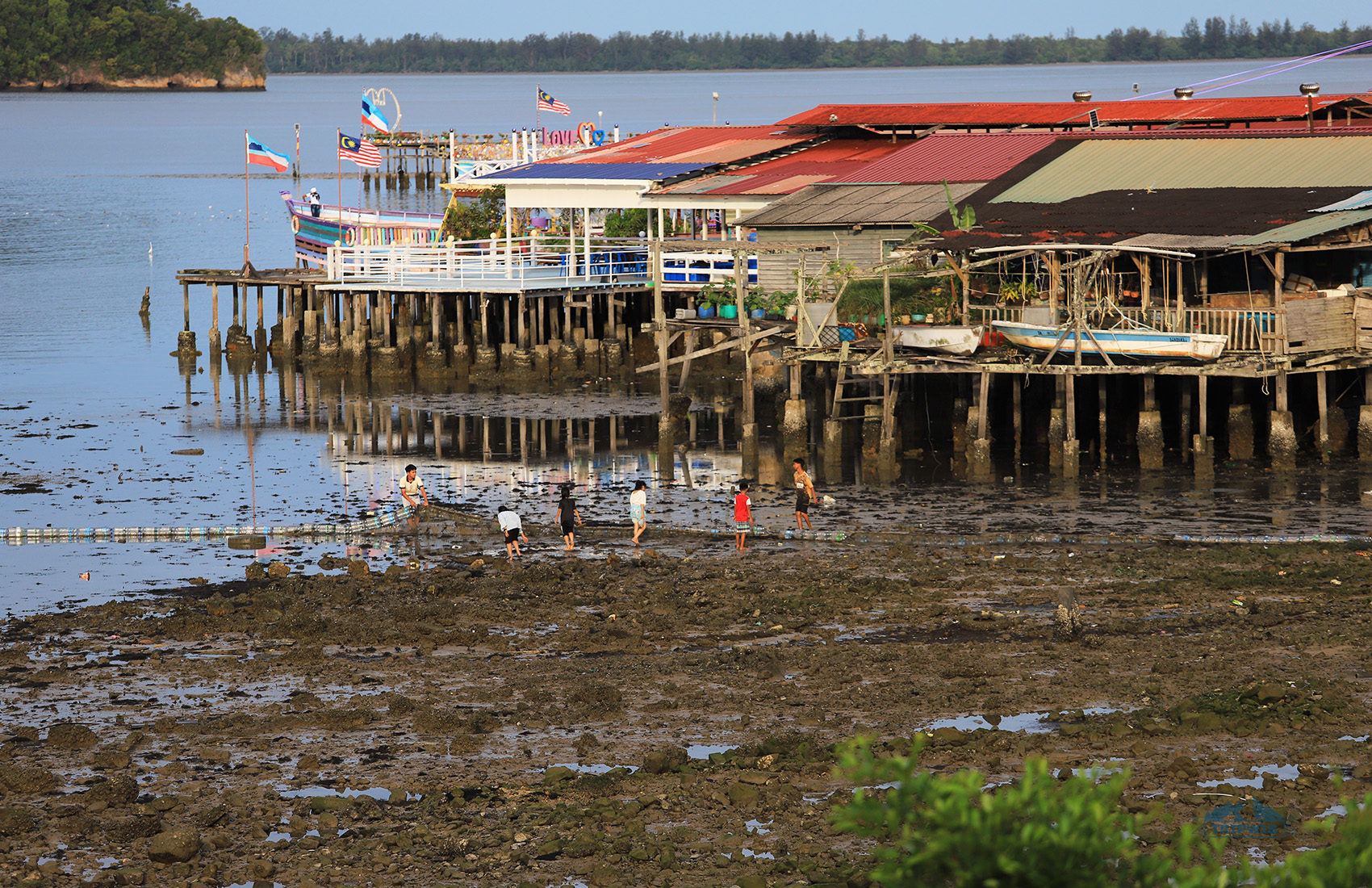
It is a particularly hard question because it doesn’t have a single answer — if you’re planning to stay close to Kota Kinabalu and make a couple of detours to a park or two, but mostly spend your days at the beach, then a week is more than enough.
However, if you’re serious about exploring all that the state of Sabah has to offer (this includes both Kota Kinabalu and Sandakan sites), then shoot for at least ten days. Conservation-centric trips or diving holidays can stretch into two weeks and even more. Account for weather changes — leave yourself some buffer days in case of heavy rains.
Apart from the frequently asked questions, I’ve come up with some essential (but lesser known) Borneo travel tips I wish we knew before visiting the island:
- Let your tastebuds run awry at Borneo night markets — it’s Southeast Asia, after all! It is the exact setting to try out unique flavor combos, and what better place to do it than street food stalls serving delectable dishes with exotic names to both visitors and locals? Even if you’re not feeling particularly adventurous, you can still find location-dependent variations of trusted dishes: Satay (charcoal-grilled meat skewers) and nasi lemak (coconut rice with fixings) will curb your hunger in no time. Market prices are pretty affordable — just be mindful of the number of seconds you get!
- Sample the local coffee drink — Kopi Tubruk — made by boiling ground coffee with sugar (without being filtered after). Compare it to Turkish coffee if you’ve tried both! For sweetness, some Kopi drinks are mixed with condensed milk — be warned, it’s diabetes in a cup!
- Don’t forget to pack insect repellent, long sleeve shirts, and pants. Mosquitos and leeches are present in the rainforest (it’s the tropics, duh), so prevention of potential diseases is paramount.
- When booking a seat on an intercity bus, don’t be shy and ask the attendant about the bus model and the comfort levels. Different operators offer rides at approximately the same rates, but the vehicles can vary greatly. If you don’t want to spend hours inside a tin can that looks like it’s on its last leg, then be annoying and ask lots of questions beforehand.
- Speaking of bus rides, don’t forget to bring a warm layer on board. The AC inside Malaysian buses is usually set to Antarctica levels, and a hoodie or a shawl will keep you relatively warm during the ride.
- Go heavy on sunscreen and other sun protection measures when in Borneo. The sun here is truly equatorial — you will burn within minutes. I have noticed many travelers wearing head-to-toe protection: Rash guards, leggings, hats, sunglasses, and even thin gloves and socks (!) while in the water. Though it seems like an overkill, these precautions are a normal thing in Borneo. They also prevent jellyfish stings, which is a huge plus for snorkeling and diving enthusiasts!
- Download the Grab app for easy taxi use all across Borneo (there’s no Uber on the island).
- While you’re on the downloading streak, make sure you have some offline maps ready of the places you plan to visit in Borneo, just in case.
- In order to stay connected while on the island, purchase a SIM card in a Borneo airport you settled on. U Mobile has a special U Prepaid Borneo plan — you get 2,000 GB (5G), 200 GB (4G), unlimited hotspot, and unlimited local calls for 20 MYR ($4.85) / month.
And there you have it! I hope that my Borneo, Malaysia travel guide has helped you plan the best island adventure you’ve ever dreamed of — the one filled with wildlife, rainforest walks, snorkeling, and eating yummy local food!

